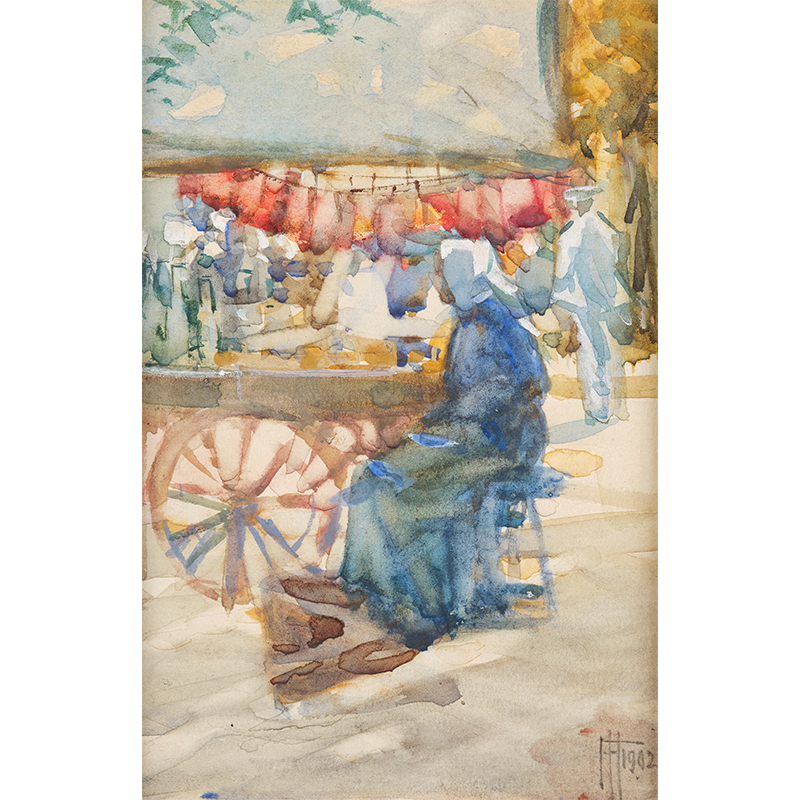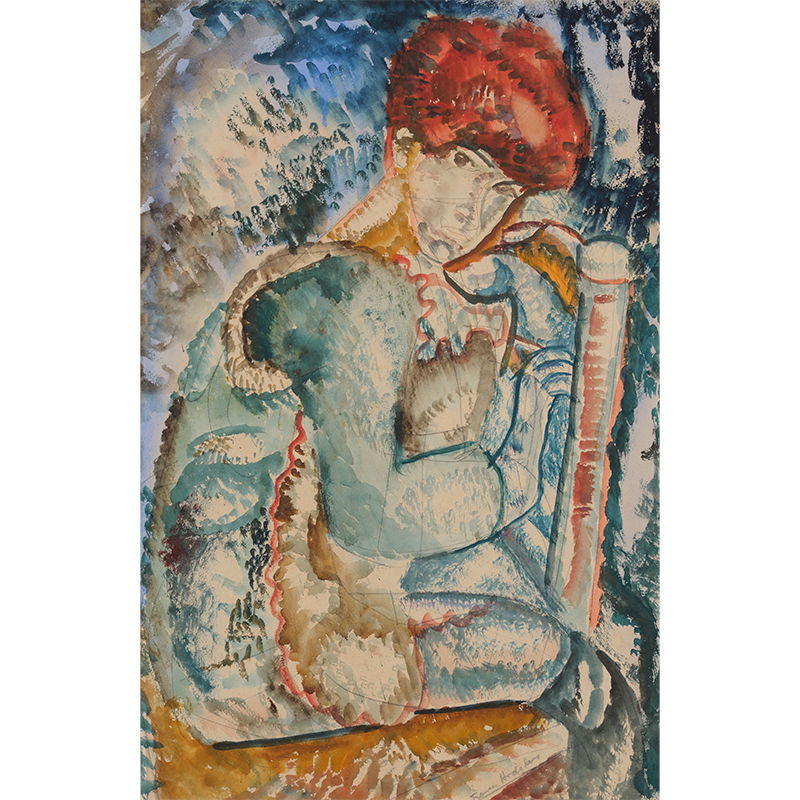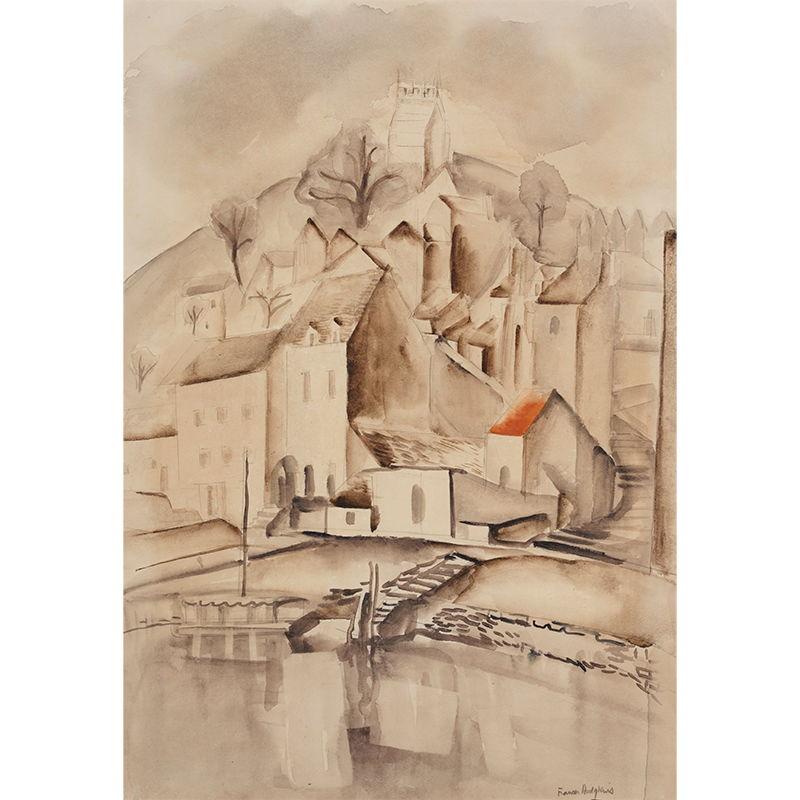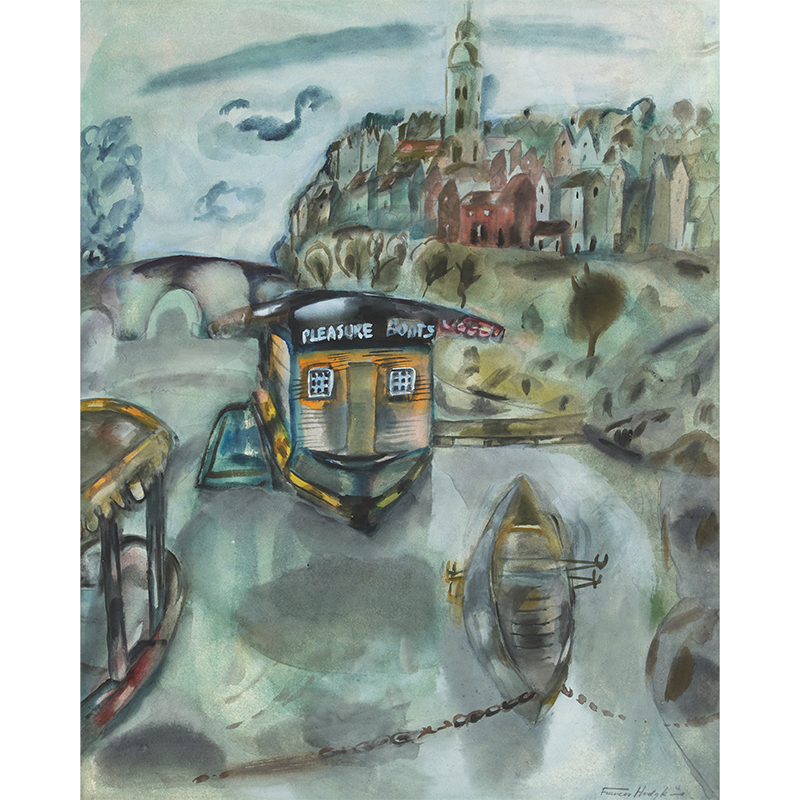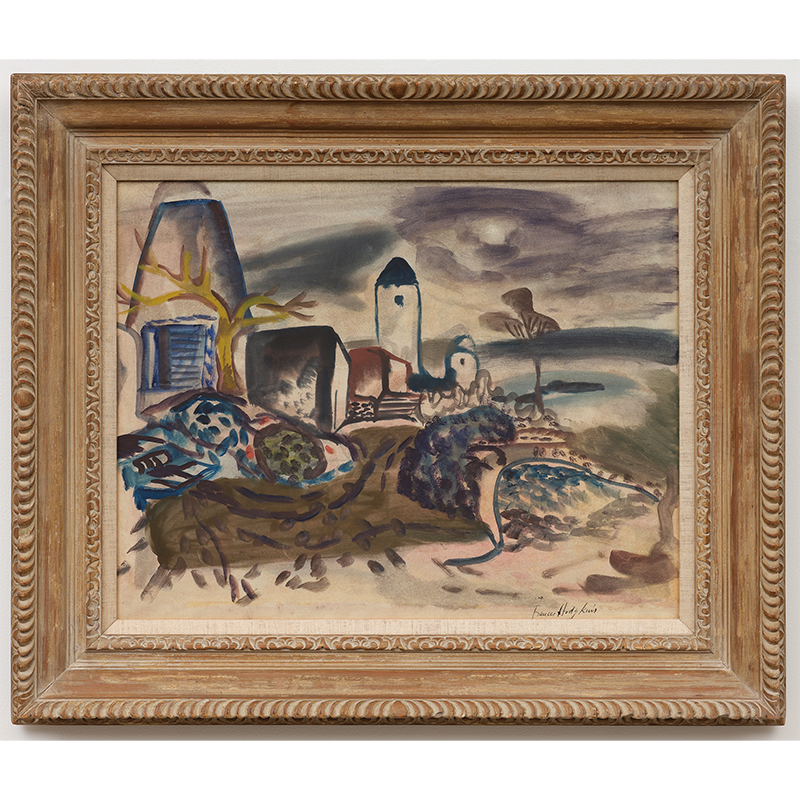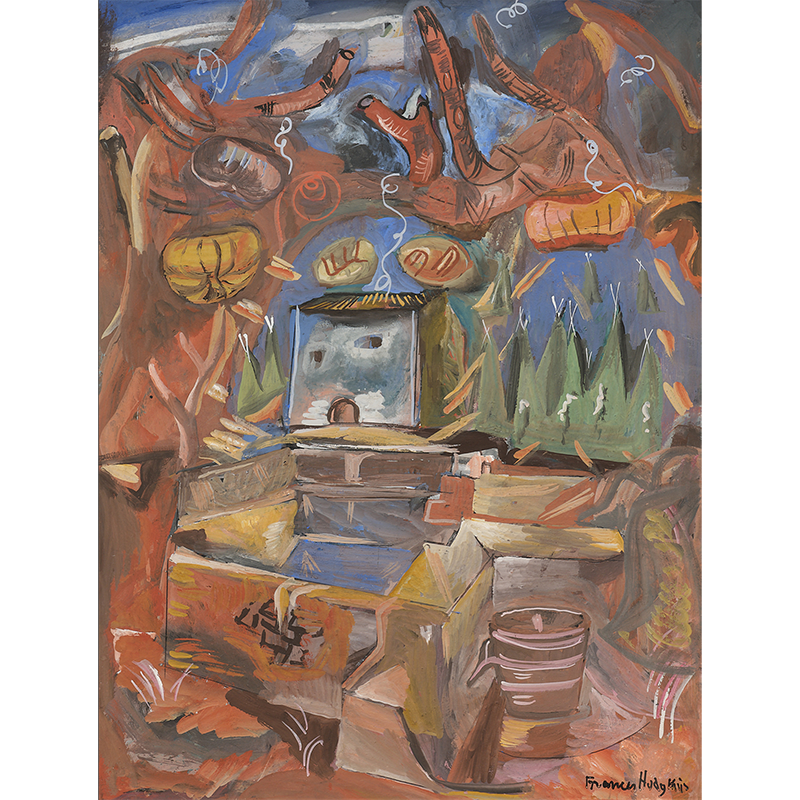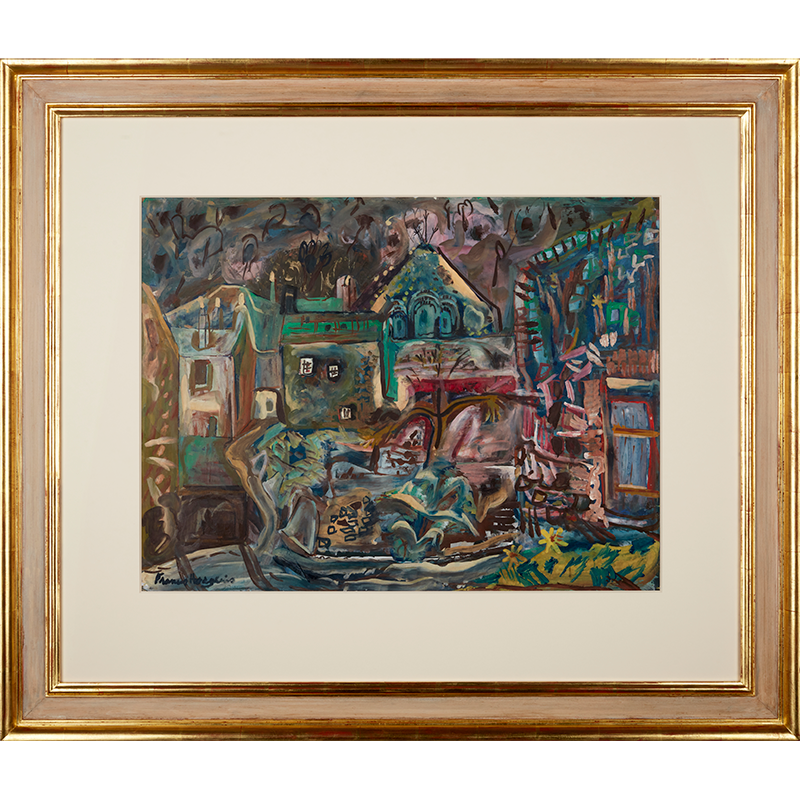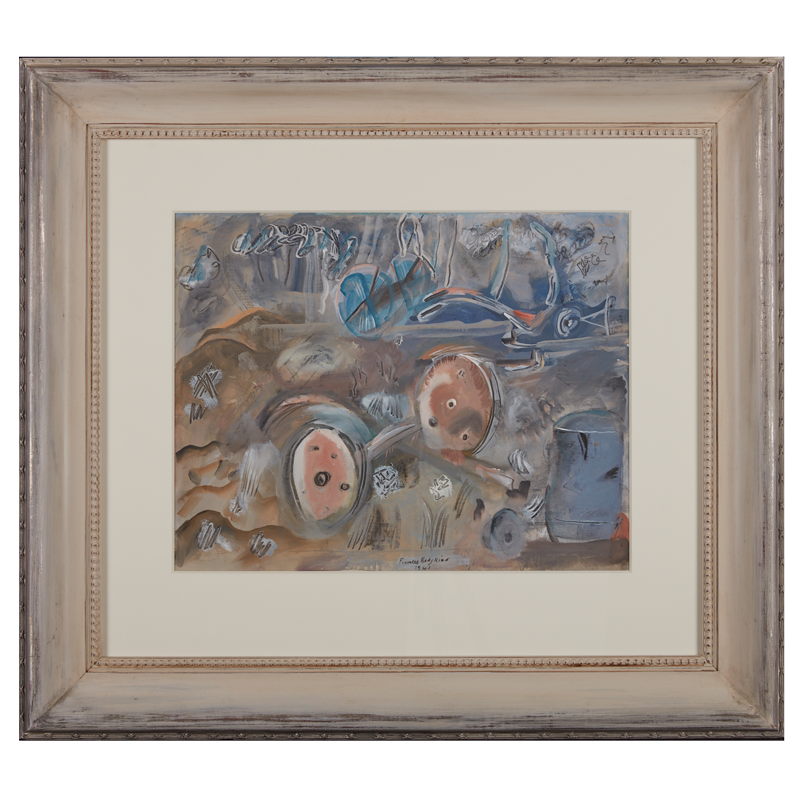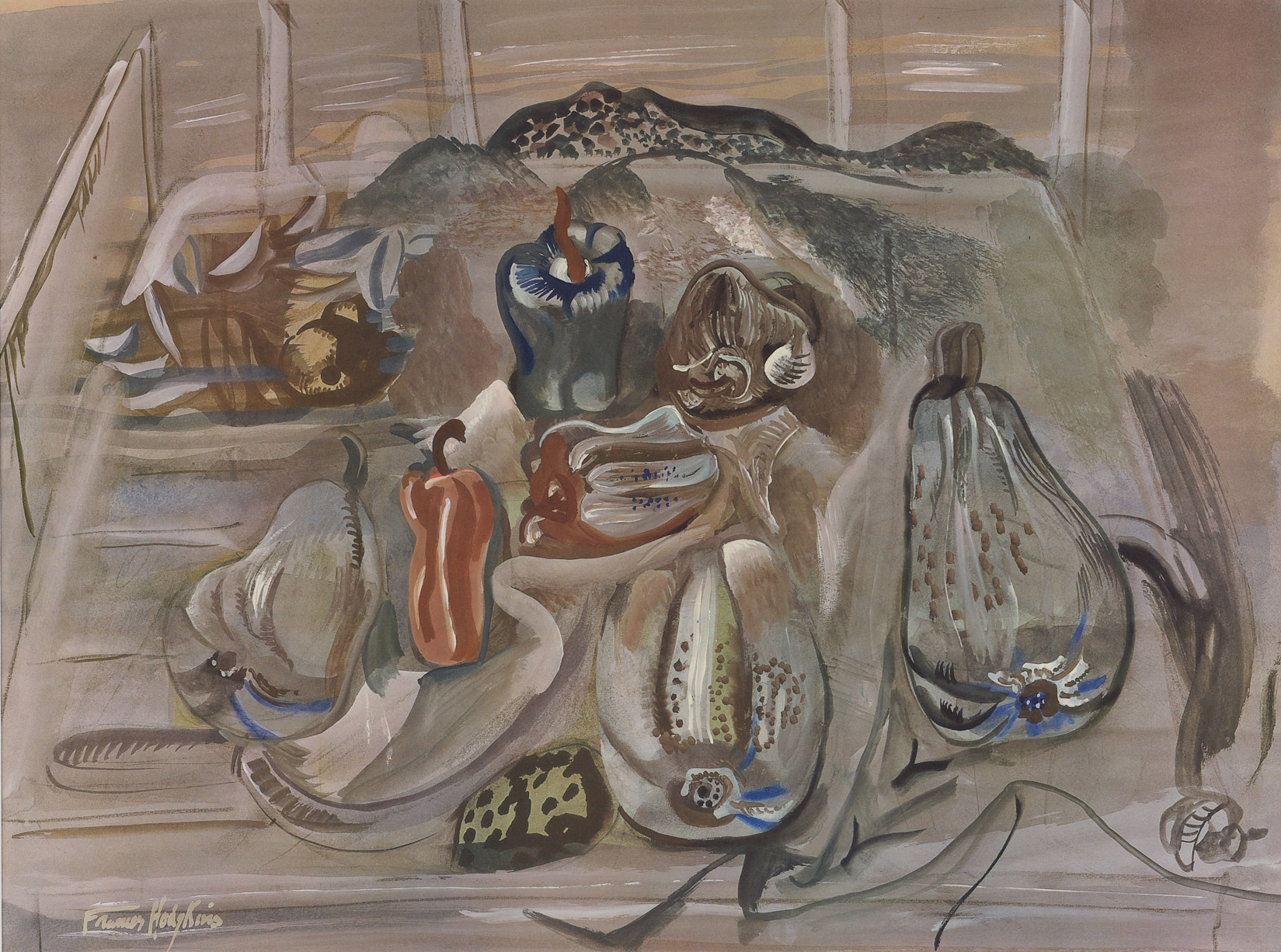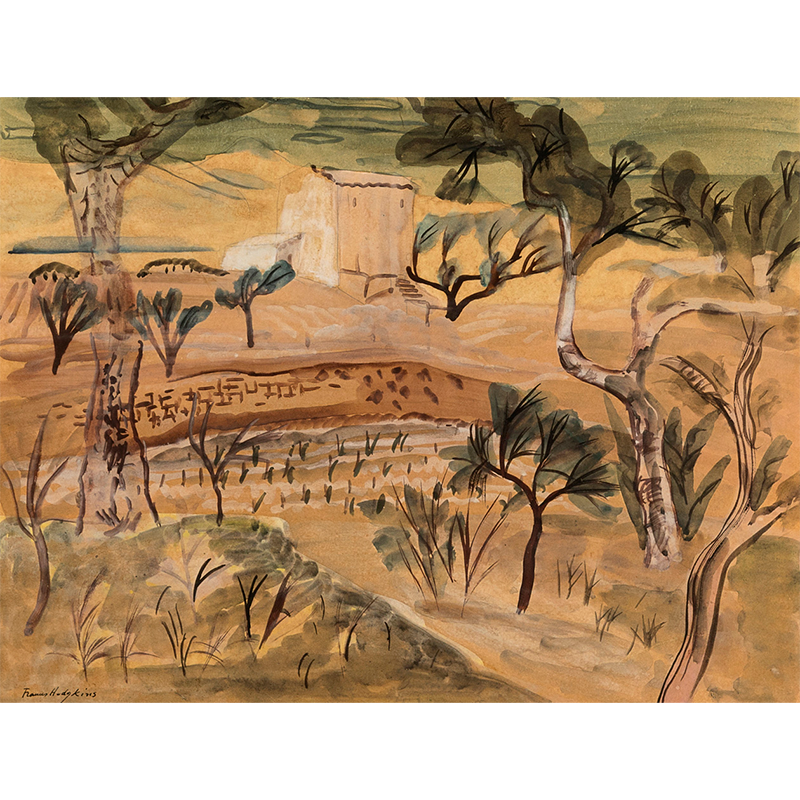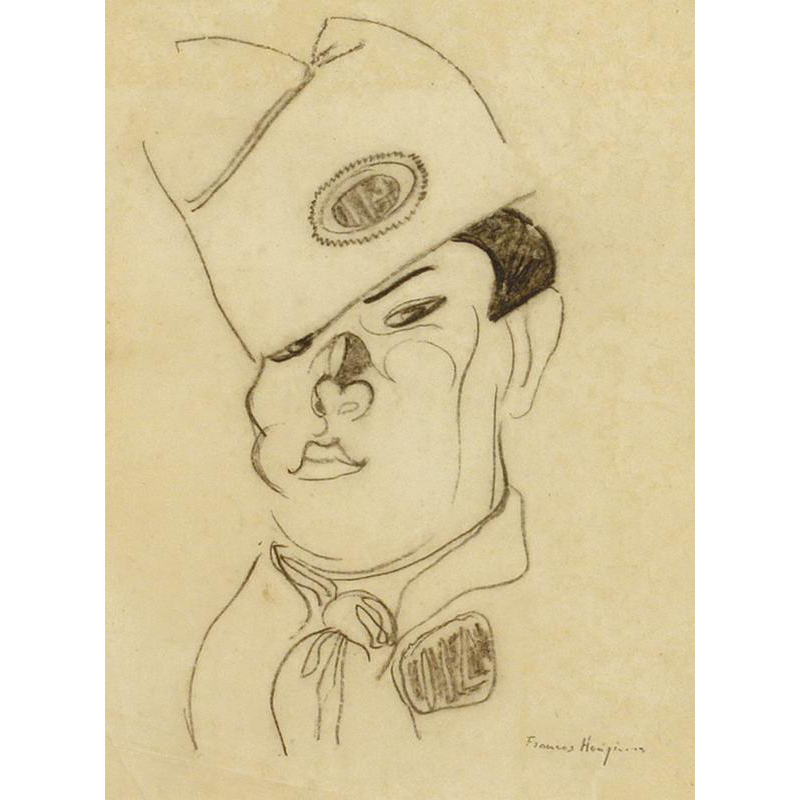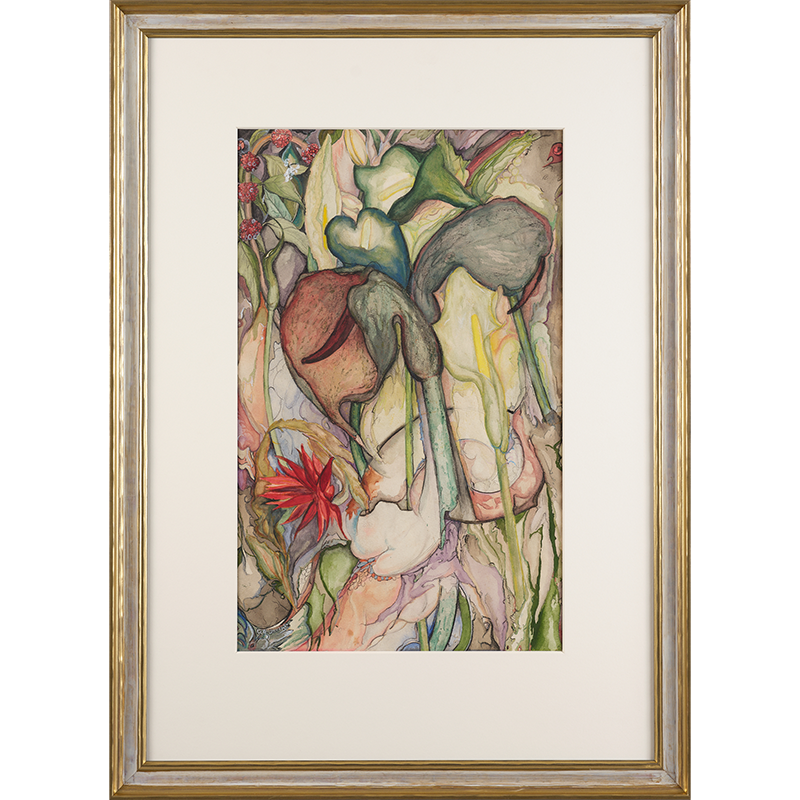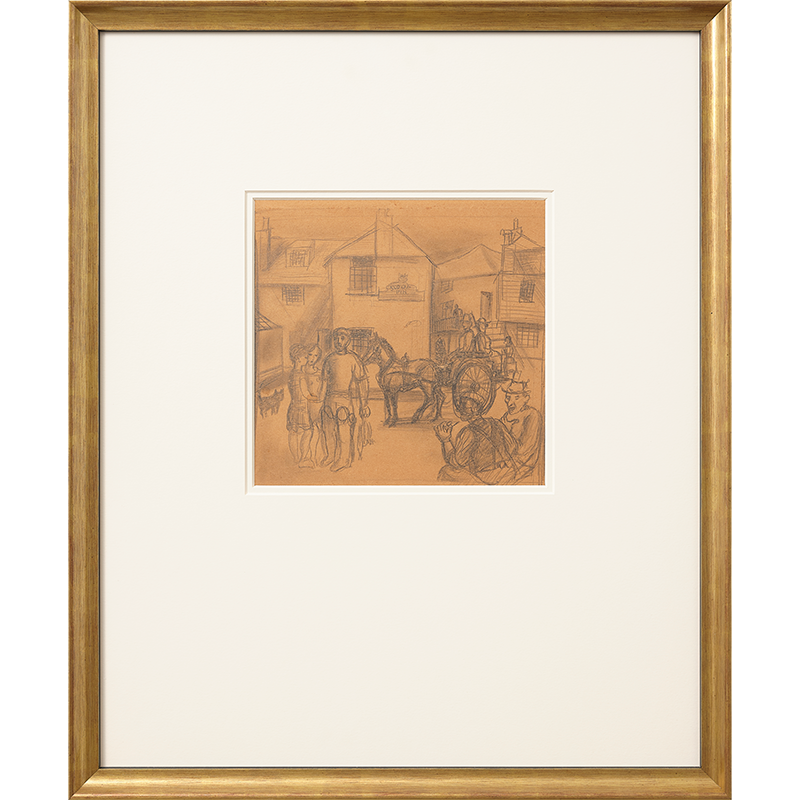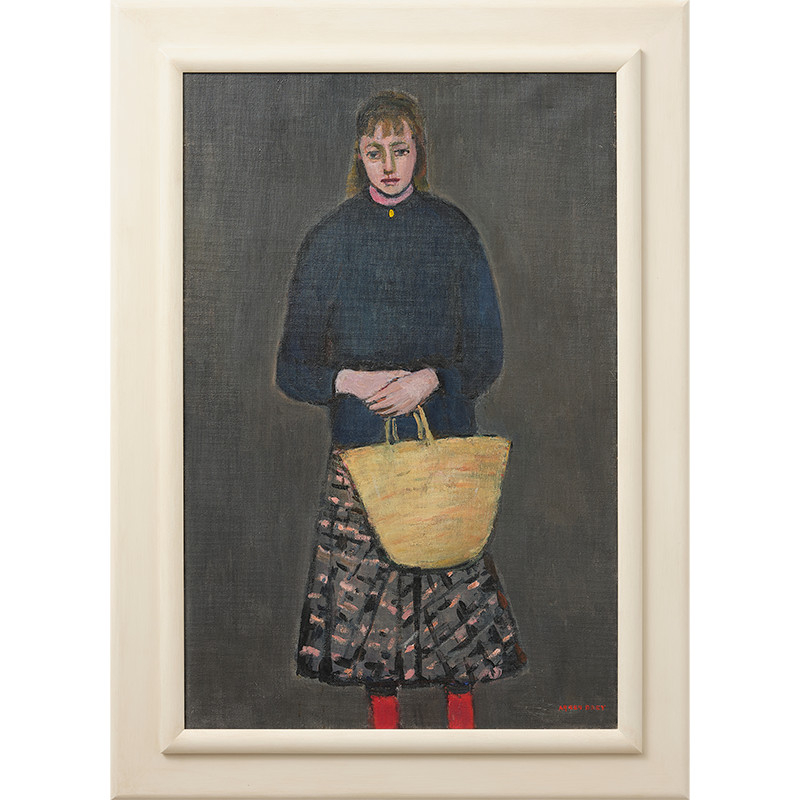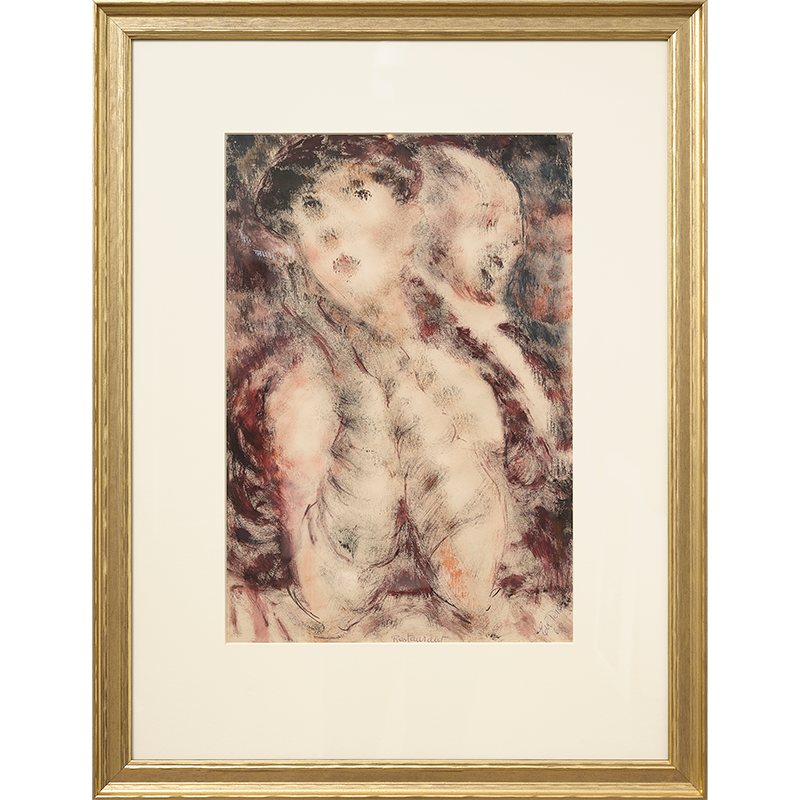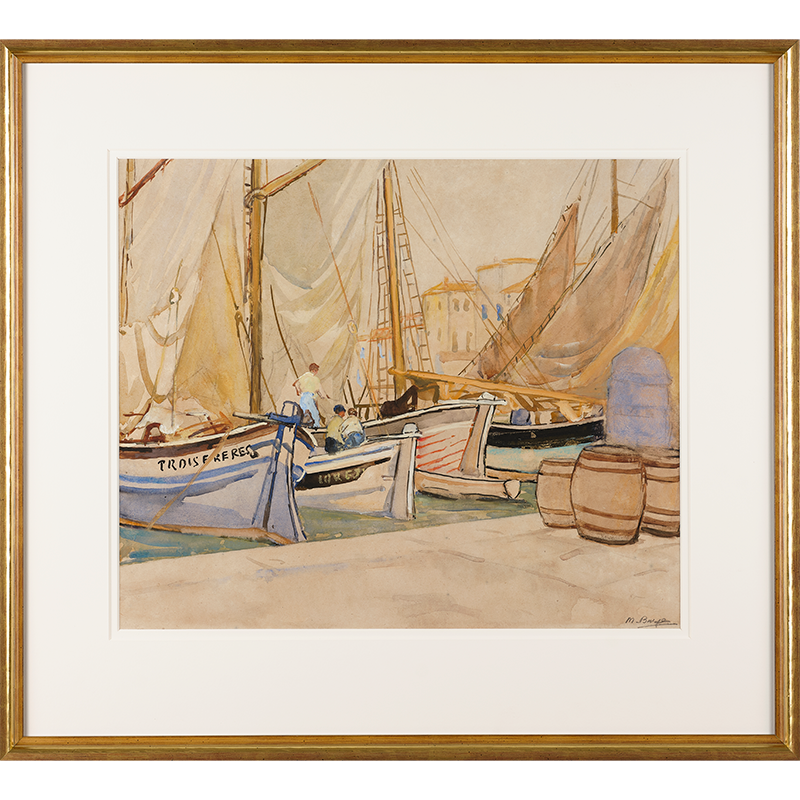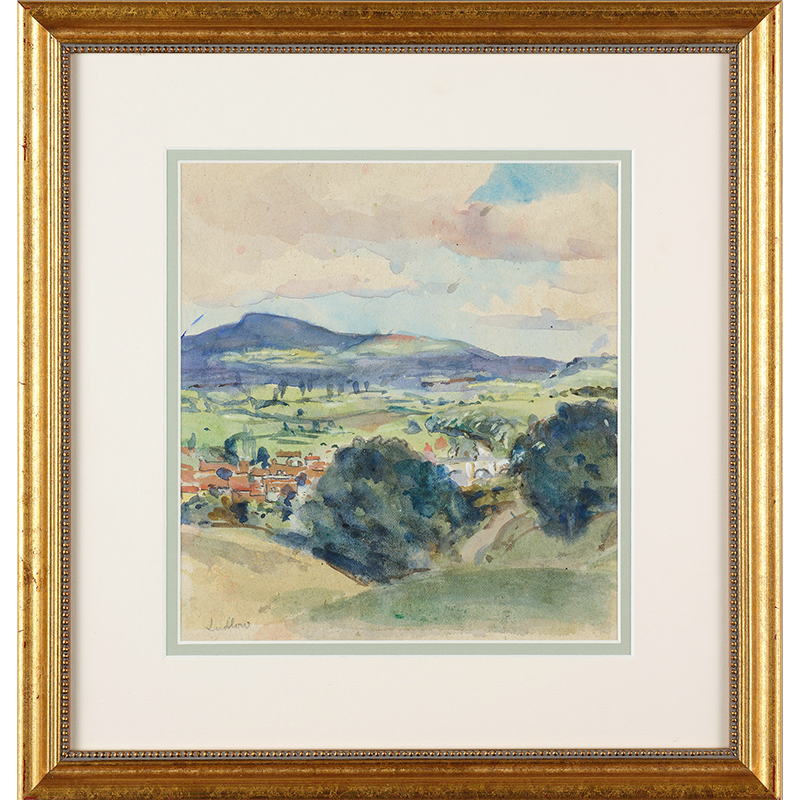Blog
FRANCES HODGKINS
A Personal Perspective
8 - 28 November 2022
Frances Hodgkins - A Personal Perspective
Four years in the making, the exhibition, Frances Hodgkins – A Personal Perspective, scheduled to open at Jonathan Grant Gallery in November 2022, will feature a collection of original watercolours and gouaches by Frances Hodgkins. The exhibition will be accompanied by an extensively researched catalogue with essays by Mary Kisler, Curator Emerita at Auckland Art Gallery Toi o Tamaki and Jonathan Gooderham, Director of Jonathan Grant Gallery.
With a career that spans fifty-six years, Frances Hodgkins was amongst the avant-garde of her generation. During her time abroad she garnered knowledge of traditional artistic styles and forged her own distinctive modernist approach to become one of New Zealand’s leading expatriate artists.
This exhibition includes works that are being shown in New Zealand for the first time, in particular Girl Seated on a Chair c.1927 which is defined by Hodgkins’ vigorous brushstrokes and bold use of colour. The paintings featured in this exhibition carry with them extensive provenance histories and detailed catalogue essays and in many cases, their actual locations visited and documented by Jonathan Gooderham.
Where possible the original frames have been preserved, along with the exhibition labels, which all add to the importance of these works.
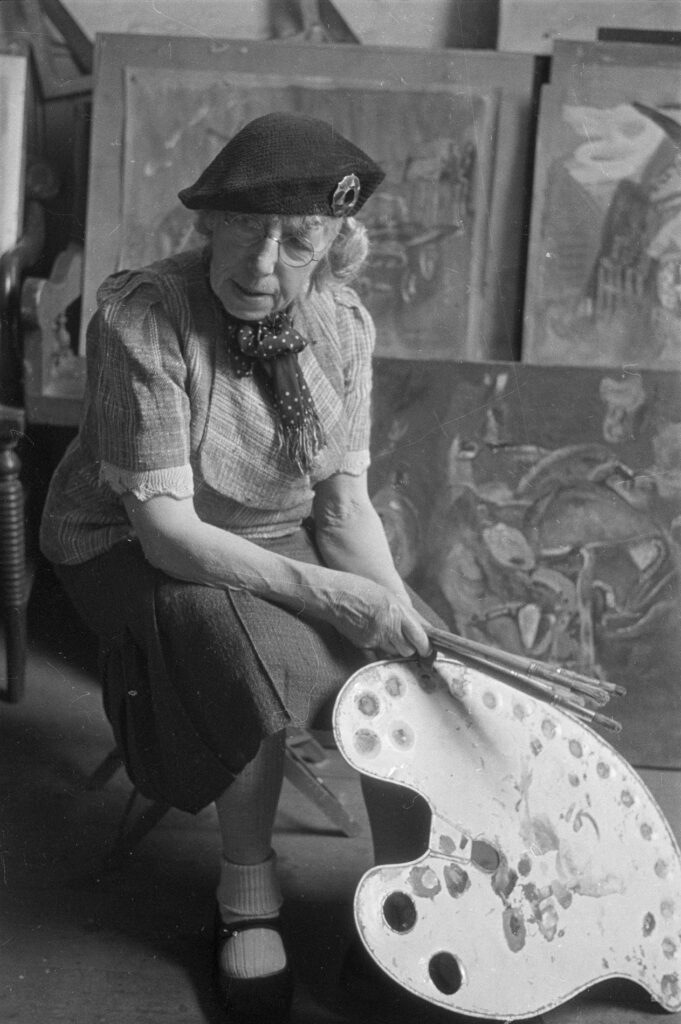
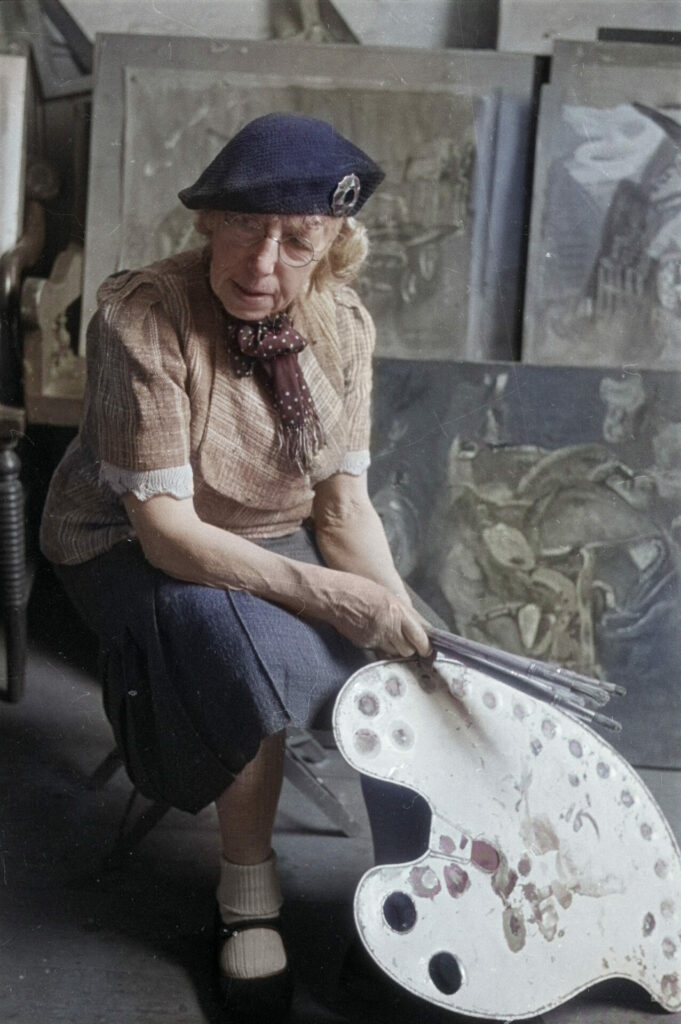
Frances Hodgkins at her Studio, Corfe Castle Village, Dorset
E.H. McCormick Archive of Frances Hodgkins Photographs,
E H McCormick Research Library Auckland Art Gallery Toi o Tamaki
Exhibition Works
A Street Market in Brittany 1902
Watercolour on paper, 17 x 12 cm
Signed FH lower right, dated ‘02
Provenance
Private Collection, Wellington
Literature
Frances Hodgkins database (FH1322) www.completefranceshodgkins.com
From Frances Hodgkins to Rachel Hodgkins, 28th July 1902, Rue de l’Apport, Dinan
“I have been very industrious and up at 6 & out working by 7.30. The French are such early birds and the streets just as busy then, in fact busier than later in the day. Dinan is a first rate place – A variety of everything – old streets, peasant women, fruit stalls, river scenery, feudal castles & two “dashing” cavalry regiments … I am sending out next week all I had for the November show which leaves me with an empty portfolio and it will be several months before I can hope to get some decent works together again.”
SOLD
Market scenes were the essential element of Frances Hodgkins’ first trip to Europe between 1901 and 1903. Living in the villages of Brittany in close proximity to the cafés and markets she carried small, easily portable watercolour sketching pads and paints enabling her to capture the picturesque vibrancy of village life en plein air.
Frances Hodgkins left New Zealand for the first time in February 1901 and from July that year spent five months in France, joining the painting classes of Penzance-based Norman Garstin at Caudebec-en-Caux. It was here that she met and made friends with English artists Maud Nickalls, Mrs Ashington, Peter Moffat Linder, Norman Garstin and his wife, and Auckland-born Dorothy Kate Richmond.
In 1902 she once again joined Garstin’s classes in Dinan, Brittany, arriving in the midst of a three week festival. These painting classes enabled her to immerse herself in her art for the first time, without the distractions of family, domesticity and teaching obligations. However, she needed to supplement her modest savings with sales, and assuming that everyday life in turn-of-the-century rural France would appeal to New Zealand buyers, she sought suitable subject matter in the open countryside and towns. Subsequently the majority of these paintings were sent for exhibition in New Zealand.
Hodgkins’ market scenes were produced rapidly en plein air, as reflected in the fluidity of her ‘wet-on-wet’ brushwork, capturing a sense of the colour, action and informality of village life. But such an approach was not without its challenges, for Hodgkins was mindful that a female artist at an easel in the market-place was guaranteed to attract comment and the curiosity of the locals.
Writing to Isabel Field in September 1902 Hodgkins complained that “the market scenes are the outcome of great mental strain with nerves at a tension and eyes bewildered with an ever-moving crowd” and notes the necessity to remain alert to the effect and relations of one thing to another.
A Street Market in Brittany depicts a typical farmers market, most probably Dinan, with the emphasis on the market stall holder sitting patiently on her stool in the hot sun dressed in the costume of the period, a blue corset dress and white calico bonnet. Her unshaded barrow du marché displays cheese. A man in his ‘whites’, most likely a butcher, stands at another stall in the middle distance with a hint of the market square trees in the background. Both figures wearing similar costumes are also evident in two 1902 watercolours, In the Meat Market, Dinan (FH0368, Private Collection) and Marketing, Dinan (FH0451, Aigantighe Art Gallery, Timaru) both of which were exhibited at the Otago Art Society in 1902.
Hodgkins sent watercolours of Dinan to her sister Isabel for exhibition in New Zealand in 1902 and was unhappy with the prices Isabel sold them for at McGregor Wrights Gallery in Wellington. “I did not know whether to laugh or cry when I got your letter … Of course I am touched & proud that they have sold so well, but was it wise dear to let them go for so little? A lump rises in my throat when I think of 12 pictures selling for £40.” She suggested Isabel ask higher prices in the November 1902 Otago Art Society exhibition in Dunedin to help recoup expenses from her recent travels in Europe.
Hodgkins’ market scenes are represented in the permanent collections of the Dunedin Public Art Gallery, Auckland Art Gallery Toi o T¯amaki and the Museum of New Zealand Te Papa Tongarewa.
– Jonathan Gooderham
Girl Seated on a Chair c. 1927
Gouache, 53 x 34 cm
Signed Frances Hodgkins lower right
Provenance
Frances Hodgkins’ studio, Corfe Castle
Marjorie Heather 1905-1989 (purchased from Frances Hodgkins’ studio)
Thence by descent to Private Collection, Norfolk, UK
Literature
Frances Hodgkins database (FH0793) www.completefranceshodgkins.com
From Frances Hodgkins to Dorothy Selby, 21st January 1928, Hotel Moderne, Martigues, Bouches du Rhone, France
“Martigues is half Spanish – I have a small room in the Spanish quarter where I have models …
there is no chasing and begging on bended knee as at Tréboul – they are only too pleased to sit and gaze at you with immense eyes for as long as you like.”
SOLD
At the beginning of 1927, Frances Hodgkins set up her new studio at Grosvenor Street in Manchester in preparation for teaching. With several friends, she hired a model, who had to pose semi-clad, as if basking at the seaside instead of the freezing cold of a Mancunian winter. This marked a new approach to the human figure, not as a feature in a landscape or in a portrait, but as a form to be studied for mass, line, and structure.
In June, with the promise of a week’s teaching with Dorothy Selby, who paid generously, she travelled to Tréboul, Brittany, staying in a chalet with her friends Cedric Morris and Arthur Lett-Haines. The presence of fellow artists with whom she could discuss recent developments in art, new directions each was taking, and critiquing each other’s work were invaluable. In Manchester she had painted a series of local mill girls, appearing timeless in their shawls like modern Madonnas, their forms delineated in thick, fluid brushstrokes that appear to caress the surface on which they are painted. None of these prepares the viewer for the radical experimentation that emerged in Hodgkins’ work once back in Tréboul. Painting with gouache with a thinly loaded brush, she developed new stippling effects, pressing the end of the brush hard onto the surface so that one can differentiate the tiny lines caused by each bristle. The rich blues and greens so loved by the Impressionists, the first group to influence her development in the early days, are almost obliterated, overlain by dark ochres, navy and black, and she introduces rapid parallel marks delineating parts of the body, as if appliquéing arms and legs onto the surface. Seated Woman and Portrait of a Woman (see FH0806, Auckland Art Gallery Toi o T¯amaki and FH0794, University of Otago) are but two examples of this technique. Boldly drawn lines are visible beneath the paint, seemingly unrelated to the painted form.
Gradually, as if her creative spirit has been irresistibly infused with Mediterranean warmth, colour starts to dominate, overlain initially by darker strokes, which are gradually moved to the margins of her compositions. In Girl Seated on a Chair, the model in question sits backwards on a traditional rush-woven seat – the kind loved by Braque, Picasso, and Van Gogh – her hands gripping the lower rung. She wears a short, ruffled dress over a plain blue blouse, an exuberant ochre line wriggling round the neck, down the side seam and around the hem. The pattern on her dress in indecipherable, as if a shoal of fish is swimming over the surface – a deliberate choice by an artist who had produced highly controlled designs for the Calico Printing Company in Manchester the year before.
The model’s unruly red hair is kept under control in a fashionable bob, and long socks reach over her knees. Rapid diagonal brushstrokes fill in the upper left corner, unrelated to figuration, yet heightening the mood of the work. Most remarkable is the girl’s expression. She stares suspiciously at the artist from under her dense fringe, her mouth a tight line, suggesting that though young, she already knows her own mind. It is a revolutionary work within Hodgkins’ oeuvre. Eric Newton later described Hodgkins experiments with gouache as “just rich enough to give her a full chromatic range and just flexible enough not to interfere with her fine, wild handwriting.”
But what led to this rich experimentation? The year before Hodgkins had lost her mother in April, her death finally assuaging the guilt of a daughter who had chosen career over duty. Two months later, Norman Garstin also died. When Hodgkins first moved to Europe in 1901, he recognised a fellow artist rather than an initiate, encouraging Hodgkins on her determined path. Possibly these two events, once she had come to terms with their loss, set Hodgkins free psychologically. This period in Tréboul culminated in watercolours of Breton fisher boys in which black is almost eradicated, and Hodgkins is immersed again in luminous blues and greens (see FH0791 Three French Sailors, Museum of New Zealand Te Papa Tongarewa and FH0792 Boys Heads, Tréboul 1927, Auckland Art Gallery Toi o Tamaki).
– Mary Kisler
Bridgnorth c. 1926
Pencil, ink, watercolour & wash on card, 50 x 35.5 cm
Signed Frances Hodgkins lower right
Provenance
Private Collection, U.K.
Exhibited
Manchester, 2 Mount Street, Frances Hodgkins, 4-30 November 1926, No.47/48
Literature
Roger Collins and Iain Buchanan, Frances Hodgkins on Display 1890 – 1950 (Hocken Library 2000) p. 59
Frances Hodgkins database (FH1321) www.completefranceshodgkins.com
SOLD
From Frances Hodgkins to Isabel Field, 3rd December 1926, Manchester
“I have been very busy. I opened a Show of my Paintings on the 4th Nov and yesterday it closed. It has been a success – in spite of the badness of the times & the foulness of the weather … I have had a good & friendly reception – sold over £100 worth – which is considered good for Manchester where there is no great picture buying public as in London … With the proceeds – and greatly helped by the big advertisement & publicity – I am starting a Studio in Town and begin my Painting Classes (night & day ones) at the New Year. “
Surmounting the High Town of Bridgnorth stands the ruins of Bridgnorth Castle, begun in the 12th century by Robert de Belleme, Earl of Shrewsbury. Today, it leans at a perilous angle, a beloved folly standing in the midst of Victorian gardens. One of the reasons Frances Hodgkins delighted in Bridgnorth (she taught there over several summers between 1926 and 1932) was the variety of views and combinations of architectural and natural forms that were readily available. This work stems from her first visit in 1926, a momentous year marked by the loss of her mother in April, a rite of passage that filled her with grief, but also set her free from the ongoing guilt of not following society’s expectations of the unmarried and dutiful daughter. Now she was free to follow her own course, and creatively she returned to the memories of France that influenced her most adventurous and confident compositions. Having spent a brief time in Ludlow, she moved to Bridgnorth, a relatively short journey, but one that proved a turning point in her painting.
When Royal Academy President E J Poynter painted a similar view in 1885, he had emphasized architectural detail – every brick on each building carefully delineated, a half-timbered cottage standing out in the foreground, smoke curling up from numerous chimneys; boys on the river plying their skiffs, and the steep path leading up to the upper town, the tower of the ruined castle standing out on the skyline.
While Hodgkins has painted her watercolour from a similar vantage point, hers is a modernist approach, simplifying the forms, their blank facades stacked side by side like elongated building blocks that might equally represent buildings depicted during her time in St Paul du Var in the south of France or Montreuil-sur-Mer in 1924. The tower looms in a comparable manner, but it is perhaps her treatment of the reflections on the water that is a real point of difference. Poynter’s foreground appears almost cluttered with reflections, whereas Hodgkins creates a mood mysterious.
In November 1926 she had an extremely successful one-person exhibition at 2 Mount Street, Manchester, among which were three works entitled Bridgnorth. The second example included here seems to have zoomed in, removing the river and the castle, instead focusing on the layers of buildings, and the horizontal effects of different sets of steps. The third composition remains unidentified at this point. Manchester critic O Raymond Drey wrote in the introduction to the show’s catalogue that “she makes each stroke of her brush instinct with life.”
– Mary Kisler
Pleasure Boat, Bridgnorth c. 1932
Watercolour and gouache on paper, 52.5 x 41.5 cm Signed Frances Hodgkins lower right
Provenance
Lefevre Gallery, London, New Watercolour Drawings, October – November 1933 No. 7 Private Collection, South Africa
Redfern Gallery, London, England, 1956
Frank and Lyn Corner, Wellington, New Zealand (Purchased from Redfern Gallery, 1956)
Exhibited
London, Lefevre Gallery, New Watercolour Drawings, October – November 1933 No. 7
Auckland, Auckland Art Gallery, Frances Hodgkins 1869 – 1947: A Centenary Exhibition, Queen Elizabeth II Arts Council of New Zealand, (Exhibition label verso). 1969 Touring exhibition to Dunedin Public Art Gallery; Robert McDougall Art Gallery, Christchurch; National Art Gallery, Wellington; National Gallery of Victoria, Melbourne; Commonwealth Institute Gallery, London, February 1970
Wellington, Kirkcaldie & Stains Ltd, Frances Hodgkins, Works from Private Collections, 1 – 21 August 1989 Wellington, Te Papa Tongarewa, Museum of New Zealand, Frances Hodgkins, 19 September – 30 January 1994 Hamilton, Waikato Museum of Art and History, Frances Hodgkins: Later Works, 5 August – 28 September 1997 Waikanae, Mahara Gallery, Frances Hodgkins: Kapiti Treasures, 28 February – 2 May 2010
Literature
Arthur R. Howell, Frances Hodgkins: Four Vital Years (Rockliff, London 1951) p. 118
Frances Hodgkins 1869-1947: A Centenary Exhibition, Queen Elizabeth II Arts Council of New Zealand, Auckland, 1969 (Illustrated No. 77)
E H McCormick, Portrait of Frances Hodgkins, Auckland University Press, Auckland, 1981, p. 116 (illustrated) Linda Gill (editor), Letters of Frances Hodgkins (Auckland University Press 1993) p. 454
Iain Buchanan, Michael Dunn, Elizabeth Eastmond, Frances Hodgkins: Paintings and Drawings, Auckland University Press, Auckland, 1994, p. 140 (illustrated)
Roger Collins and Iain Buchanan, Frances Hodgkins on Display 1890 – 1950 (Hocken Library 2000) p. 68
Janet Bayly, Frances Hodgkins: Kapiti Treasures, Mahara Gallery, Waikanae, 2010, p. 32 (illustrated)
Frances Hodgkins database (FH0994) www.completefranceshodgkins.com
From Frances Hodgkins to Dorothy Selby, 14th August 1932, Kings Lynn, Norfolk
“… we are leaving Tuesday morning for Bridgnorth my old love … I am tingling with impatience to get started – & at work – On reaching Bridgnorth I’ll either wire you – or send you card to reach you Wed: morning – I hope to find rooms all together in the Town nr. river – & promise not to put you up a hill by yourself as last time … Till Thursday then – at Bridgnorth.”
In August 1931, Frances Hodgkins returned to London from Martigues and St Tropez. Four months later she moved to Bodinnick-by-Fowey in Cornwall, attracted by the prospect of painting landscapes. In February 1932 she exhibited at the Leicester Galleries in London with the Seven and Five Society which was formed in 1919. The seven painter members were linked by the freshness and simplicity of their imagery and the direct way in which the paint was applied and, in addition to Hodgkins, they included Winifred Nicholson, Ben Nicholson, Christopher Wood, Ivon Hitchens and Cedric Morris. Morris was a great supporter of Hodgkins’ work, and in 1928 painted her portrait which is in the collection of the Auckland Art Gallery Toi o Tamaki. Sculptor members of the Society included Henry Moore and Barbara Hepworth.
Hodgkins had first shown with the Seven and Five Society in March 1929, when six of her paintings were included in its ninth exhibition. On this occasion the reviewer for The Times considered Hodgkins “most sure of her ground; her two oils, Boy in Wood (FH0853, Christchurch Art Gallery Te Puna o Waiwhetu) and The Garden, were both elegant pictures … grotesque, but consistently so, as if the artist obeyed her natural vision of things.” Hodgkins also had two paintings in the Seven and Five Society’s tenth exhibition in 1931, and in the eleventh the following year she had six. She also exhibited in three other London dealer galleries in 1932; Zwemmer Gallery, Tooths and Wertheim Gallery.
By April 1932, Hodgkins was feeling more financially secure, especially so when the co-director of the Lefevre Galleries in London took her to lunch and offered her a new year-long contract with an annual income of £200 and the probability of renewal. The agreement would be renewed in July 1938, but was cancelled in November the following year because of the outbreak of war. As noted by Iain Buchanan, while a salary of £200 in 1932 was by no means lavish, it was a reasonable sum for an artist at that time, especially so as contemporary art was difficult to sell and economic conditions were uncertain.
As Hodgkins herself commented on her change of fortune with her securing the contract: “Funny how these favours come thick & fast when you are established in safety.”
Later in 1932, Dorothy Selby, who had contacted Hodgkins back in 1923 requesting lessons, visited her at Bodinnick-by-Fowey. They spent time with other friends, including Hannah Ritchie and Jane Saunders in Bridgnorth, an old market town on the Severn in Shropshire where Hodgkins had conducted successful summer painting classes in mid-1926. The combination of the season and the company provided the stimulus for a number of works from this period. As described by Joanne Drayton, they showed the influence of French artists, the “shimmering playfulness and hot piquancy that is more reminiscent of Raoul Dufy than of the British avant- garde.” These works included several inspired by the pleasure boat section of the River Severn, among them Sabrina’s Garden (FH1012, Bristol Museum and Art Gallery), Sabrina being the Roman goddess of the river, and the present Pleasure Boat, Bridgnorth (FH0994). The latter, along with Boathouse on the Severn (FH0998, Private Collection) were among the 32 works in Hodgkins’ New Watercolour Drawings exhibition at the Lefevre Galleries in October/November 1933.
The exhibition also included the 1932 watercolour Pleasure Garden (FH0995, Christchurch Art Gallery Te Puna o Waiwhetu ̄ ), which was the subject of much controversy in 1948 when it was one of six paintings by Hodgkins sent from London on approval to the Canterbury Society of Arts in Christchurch. When the Society decided against making a purchase, a group of citizens subscribed funds and bought Pleasure Garden for the collection of the city’s Robert McDougall Art Gallery. Debate raged when the City Council declined to accept the offer, and finally, in 1951, when the art gallery’s advisory board was more sympathetic towards modern art, it voted to accept the painting.
The eponymous vessel in Pleasure Boat, Bridgnorth dominates the centre of this composition, with a view of the River Severn and a cluster of tall and closely packed houses and hills beyond. Pleasure Boat, Bridgnorth is painted from a vantage point further along the river, so that rather than the ruined tower of the castle in the High Town, the copper cupola atop the tower of St Mary’s Church leads the eye upwards. Whereas in her 1926 watercolour, cloud billows evenly over the scene, here squiggly clouds drift off above a simplified bridge (a contemporary photograph shows that it had two arches) that leads across to the opposite riverbank.
A distinguishing feature of this watercolour is the artist’s change of perspective; whereas the barge itself is depicted obliquely, from the front, a canoe on the river is seen from directly above, as in a bird’s-eye view. Hodgkins places her major focus on the pleasure boat landing stage further along the river.
The same historical photograph shows how accurately she interpreted it. One of its vessels hoves into sight in the foreground, its ruffled canopy possibly reminded Hodgkins of the popular song,“Surrey with a fringe on top.”
Hers is a witty approach, emphasising the anthropomorphic ‘face’ of the landing stage. The skiff in the foreground mirrors those that populate Poynter’s 19th century watercolour, while the pleasure boat also hovers in her earlier watercolour of Bridgnorth, its structure reflected on the water’s surface. In Pleasure Boat, Bridgnorth, by comparison, Hodgkins captures the liquescence of the water itself, a focus that continued to capture her interest throughout her later career. Importantly, there are no figures here to populate the scene – hers is a pure landscape painting, a study in cloudscapes, riverbank and the Severn itself, the stage’s humorous face addressing the figure beyond the picture plane – that of the viewer, rather than the viewed.
Beyond the vessels in Pleasure Boat, Bridgnorth can be seen the treelined river bank, the narrow and steeply-roofed houses of Bridgnorth captured here in an economic and impressionistic manner, but also showing enough detail to capture the essence of the town.
Storm (Ibiza) c. 1933
Watercolour & gouache, 40 x 52 cm Signed Frances Hodgkins lower right Inscribed under mount Storm – Ibiza II
SOLD
Provenance
Mrs Rée A Gorer, Highgate, London
By family descent to Mr Richard Gorer (1913 – 1994), East Sussex Mr Alan Rowe, London 1973
Private Collection, France
Exhibited
London, Lefevre Gallery, New Watercolour Drawings, October – November 1933, No. 10
Literature
Arthur R. Howell, Frances Hodgkins: Four Vital Years (Rockliff, London 1951) p. 118
Roger Collins and Iain Buchanan, Frances Hodgkins on Display 1890 – 1950 (Hocken Library 2000) p. 68 Frances Hodgkins database (FH1021) www.completefranceshodgkins.com
From Frances Hodgkins to Dorothy Selby, 29th January 1933, Hotel Balear, Ibiza, Balearic Islands Spain
“Winds high & cold – ships in Harbour – seas rough. But all the time more & more almond blossom on the trees refusing to hold back for all the dirty looks from the sky. But we have ridden the storm and now for some nice weather & warmth. I have got off a batch of work to Lefevres.”
When Frances Hodgkins visited Morocco in 1902, she fell in love with the traditional architecture of cube- shaped houses, their smooth whitewashed walls perforated by dark rectangles of glass; the balconies sometimes decorated with finely traced filigree. Like so many modernist artists, their designs were to serve as important anchor points in many of her European compositions. Such buildings are vernacular, often constructed without plans, yet perfectly suited to the strong contrasts of climate that the Mediterranean provides.
When she visited Ibiza in 1932, wintering over until nearly mid-1933, these kinds of structures delighted her eye once more. During her time on the island, German Dada artist and photographer Raoul Hausmann was photographing the same buildings, providing evidence of how true to form Hodgkins’ depictions are.
The island of Ibiza is a land of contrasts. Ibiza township, where Hodgkins spent most of her time, rises from the harbour to the fortified citadel of Dalt Vila, its ramparts towering over the simple fishermen’s houses of Sa Penya below. At the end of January 1933, Hodgkins wrote to her friend Dorothy Selby, “Work with me has been at a standstill while freak weather did its worst – we all went down with Flue – one after the other – but are now better and up and doing – but no painting yet – winds high and cold – ships in Harbour – seas rough – but all the time more and more almond blossom on the trees – refusing to hold back for all the dirty looks from the sky – But we have ridden the storm …” Yet Storm (Ibiza) suggests she had hardly waited for the weather conditions abated to strike out for higher ground. This entailed climbing the steep path, lined with irregular ankle-breaking rocks to the great gates of Dalt Vila, and passing through the citadel before striking out along the ridge known as Puig des Molins (Hill of Windmills). Even today the path is rough and stony, and it would have been extremely uncomfortable traversing the ridge in stormy weather with little shelter available.
Hodgkins has carefully considered every element included in Storm (Ibiza). The delicate sails of the mills are long gone, but she captures their towers with their domed roofs, monolithic against the darkening sky. As befitting the chilly temperatures of Spring, the artist has reduced her palette. The yellow ochre tree, its bare branches highlighted by the whitewashed wall behind, complements the rich blues of the shuttered window, while patinated clumps of what appear to be the kind of brushy scrub that seems to thrive in that hostile setting, set off by the washes of brown that indicate the path. Small dabs of orange ochre, almost unnoticed at first, surround a greenish bush, its leaves demarcated in a darker tone, gestural marks rather than botanical renderings. Rather than paint the sweeping bay beyond, a soft greenish grey swirl of water suffices, encircling the promontory in the distance. Ominous dark clouds scud above the harbour, the patches of light indicating that this is a late afternoon work — one which Hodgkins must finish rapidly if she is to cover the kilometre or so of open pathway before reaching the shelter of the citadel’s walls. Hodgkins was always stalwart, and never more so in an environment like this. She loved it, returning several times to paint the Puig, but never in such inclement weather.
In May, by which time she was dating her letters in Spanish, Hodgkins wrote again to Dorothy Selby, noting that Geoffrey Gorer and his mother Rée were in Madrid and might well visit the island. We have no proof that they did, but they acquired Storm – Ibiza II from Lefevre Galleries when displayed there from October to November that year, suggesting that the work may have proved a happy reminder of a brief visit to the island.
– Mary Kisler
Pergola c. 1936
Gouache on paper, 72 x 53 cm Signed Frances Hodgkins lower right
Provenance
Lefevre Gallery, London 1937
Anthony Tuer Shawcross (1900 – 1977), Jersey, U.K. (Purchased from above in 1937)
By descent to his Granddaughter, Brighton, U.K.
Exhibited
London, Lefevre Gallery, New Paintings and Watercolours by Frances Hodgkins, October – November 1937, No. 42
Literature
Arthur R. Howell, Frances Hodgkins: Four Vital Years (Rockliff, London 1951) p. 118
Roger Collins and Iain Buchanan, Frances Hodgkins on Display 1890 – 1950 (Hocken Library 2000) p. 73 Frances Hodgkins database (FH1318) www.completefranceshodgkins.com
From Frances Hodgkins to Rée Gorer, 7th December 1935, Tossa de Mar, Gerona, Spain
“There is plenty of material here to paint. I am working up courage to start on figures – the life of the village is rich & dramatic. The little shops at night enchanting like Dutch interiors gone Spanish – and the gilded altars in the village churches, vulgar and gaudy, but in the dim light like a Rembrandt.”
SOLD
Pergola was exhibited in New Paintings and Watercolours by Frances Hodgkins at the Lefevre Galleries between October and November in 1937. A complex composition, it is derived from the highly productive time Hodgkins spent at Tossa de Mar on the Costa Brava (Wild Coast) in northern Spain from mid-September 1935 to early summer 1936. There was a strong Parisian presence among the summer guests, who loved the sparkling blue sea and brilliant skies, Marc Chagall christening it a ‘Blue Paradise’ while Dora Maar photographed her intellectual friends perched on the edge of brightly painted fishing boats pulled up on the shore. Once the autumn winds started to blow, most preferred to return to home. But Hodgkins was made of sterner material, the more isolated months giving her the quiet she needed to focus on her compositions without too much interruption.
The sweeping curve of the main bay, La Pauma (La Palma), lies spread out below pine-covered hills that rise above the village, marked at one end by the castellated ruins of Vila Vella, the sole remaining medieval fortification on the Catalan coast. When she wasn’t recording its imposing structure, Hodgkins preferred the isolation at the opposite end of the bay, not least when the river, which dried up in the summer months, burst forth once temperatures cooled. Its flow was vital for irrigating the patchwork of fields that provided much of Tossa’s food supply. Hodgkins was drawn, not to the flat rows of vegetables, but rather the infrastructure that supported their growth. Her time in Tossa de Mar was extremely productive for Hodgkins, inspiring at least a dozen of the major paintings included in the Lefevre exhibition the following year.
Pergola is a delight to study, as its location has been unknown until recently. Its subject matter, however, making witty references to several major works from the 1930s, each painting more refined than the last. Hodgkins first introduced the pergola motif into watercolours painted in St Tropez in 1931, producing an internal floral frame for a local woman washing garments at an outdoor sink, while in several English watercolours in the intervening years, it draws the eye through to the view beyond.
In Pergola the title is given to a heavily pruned tree on the left-hand side, its arch of truncated branches framing a lone white building.You can always tell when Hodgkins feels on top of her game, for the house takes on an anthropomorphic quality, its unevenly placed windows serving as eyes that gaze quizzically back at us. Floating around but not attached to the pergola are vegetal forms suggestive of seeds, gourds, and marrows, interspersed by white curlicues that rise like wisps of smoke that appear to be‘embroidered’on the surface. Patches of “blanket stitch” on the pruned branches heighten this effect. The river itself flows under the bridge in front of the house before being briefly captured in the lavadero in the foreground, where fishermen’s wives gathered daily, scrubbing their washing on the flat tops of the broad stone walls. While Hodgkins has consciously avoided the introduction of such figures into her Tossa paintings, her letters of the time attest to the women’s presence.
A water barrel on the right, which would have been filled by hand to aid the villagers’ endeavours, stands guard on the right of the wall, while the water, having served its purpose, then gushed beneath the walls before spreading its largesse over the expanse of the beach before reaching the sea. Buildings and walls allowed Hodgkins to introduce reminiscences of Cubist forms, this treatment possibly influenced by the ‘Parisian’ element of Tossa’s summer population. Either side, looking like Indian wigwams, are paller or haystacks, the hay being packed around a central tripod of bamboo. They can be seen in several Tossa paintings, including Spanish Landscape with Stooks in Grey and Pink (FH1103, Private Collection) and Spanish Landscape in Orange, Brown and Green (FH1101, Private Collection) although in the latter they are to be clad in their freshly cut mantle. Beautifully constructed, its sombre palette of browns and greens lifted by sparkling blues and whites reflective of the local marine environment, Pergola is a masterpiece.
– Mary Kisler
Terrace Garden, Ibiza 1933
Watercolour & gouache on paper, 54 x 39 cm Signed Frances Hodgkins lower right
Provenance
Lefevre Gallery, London
Dame Rebecca West (Cicily Isabel Andrews 1892 – 1983), London (Purchased from the above) Christie’s, London, 4 November 1983
Elizabeth Steiner, Auckland (Purchased from the above)
Exhibited
London, Lefevre Gallery, New Watercolour Drawings, October – November 1933, No. 5
Literature
Arthur R. Howell, Frances Hodgkins: Four Vital Years (Rockliff, London 1951) p. 113, p. 118
Roger Collins and Iain Buchanan, Frances Hodgkins on Display 1890 – 1950 (Hocken Library 2000) p. 68 Frances Hodgkins database (FH1040) www.completefranceshodgkins.com
From Frances Hodgkins to Karl Hagedorn, 29th January 1933, Ibiza, Balearic Islands Spain
“… I must say in this clear ivory light every common object looks important & significant – I wonder what you would make of subjects here – things appear in stark simplicity minus all detail – nothing corked up (bouchée) Or hidden as in grey, or brown light of the North. Of course, later on, this intense sunlight will convert colour & form into absolute negation but at the moment there is complete loveliness. The pale coloured flat roofed houses without windows give a blind restful feeling, of immense space.
SOLD
Frances Hodgkins arrived in Ibiza, Spain, in December 1932, remaining on the island for over six months. Once temperatures improved, Hodgkins regularly climbed to the walled citadel of Dalt Vila that towers over the township below. From this vantage point she had numerous views on hand, and equally importantly, the advantage of solitude, allowing her to concentrate on her work.
A favoured location was a rough path that led away from the citadel along the ridge overlooking the sweeping bay of Figueretas. As well as making studies of the windmills that lined the path, she pushed further afield, discovering a narrow set of precipitous steps leading towards the water, with little houses clinging to the hillside either side. She painted the lowest house on at least three occasions, focusing on the walled courtyard at the front. Each was painted from a different angle.
In Courtyard, Ibiza (FH1026, University of Auckland) Hodgkins paints a bird in a cage, basking in the sun, while in Ibiza, Balearic Islands (FH1018, Museum of New Zealand Te Papa Tongarewa), a cat stalks along the wall nearest the sea, animating the scene. The same courtyard is referred to in the present watercolour Terrace Garden, Ibiza 1933, but Hodgkins has moved down a step or two so that the end wall stands out against the water. It is both a subtle and masterful composition in which nothing is left to chance. The diagonals of the wall and its crenelated outcrop is mirrored by the ochre wall of the house, while the undulating line of roof tiles on the roof’s edge leads our eye across the sweeping shoreline to the line of hills beyond, punctuated by the waving verticals of a tree whose branches stand out against the sky. The rocky shoreline around the peninsula of Ibiza is covered with prickly pears and aloes that thrive in its salty environment. While it is impossible to identify the plants Hodgkins has painted, she translates their forms into a series of fluid, rapidly painted lines against the ochre dabs of the rocky wall.
In February 1934, two months after her major exhibition had concluded, Hodgkins was invited by Duncan Macdonald of Lefevre Galleries to lunch with the famous writer Rebecca West, the purchaser of Terrace Garden, Ibiza. Hodgkins replied,“… It sounds most terribly attractive meeting Rebecca West… – but I simply cannot promise to coming, feeling as I do at my very lowest ebb of intelligence…” Although reluctant, she almost certainly succumbed, and West later acquired a second watercolour, Bradford-on-Tone c.1937.
West’s married name was Cicily Andrews, née Fairfield, but she is more generally known by her publishing name of Rebecca West. She was the mother of Anthony West, who with his wife Kitty West, were influential supporters of Frances Hodgkins, and were depicted in Hodgkins’ painting Double Portrait No. 2 (Katharine and Anthony West) (FH1119) held in the Museum of New Zealand Te Papa Tongarewa collection.
– Mary Kisler
Methodist Chapel c. 1937
Gouache on paper, 48 x 63 cm Signed Frances Hodgkins lower left Inscribed on mount: No. 5 Solva
Provenance
Leicester Galleries, London 1941
Mrs Fielding (purchased from above)
By descent to Mr. L. Schoeman, Pinetown, South Africa
Stephan Welz & Co, Johannesburg, British & Continental Paintings & Sculpture, August 1993
John Leech Gallery, Auckland
Private Collection, Christchurch
Jonathan Grant Gallery, Auckland
Exhibited
London, The Lefevre Gallery, New Paintings and Watercolours, October 1937, No. 27
London, 22nd Biennale di Venezia, British Council at the Galleries of Hertford House, London, May – June 1940, No. 107
Leeds, Leeds Art Gallery, Works Selected for the Venice Biennale, August 1940
London, The Leicester Galleries, Paintings and Watercolours, September 1941, No. 131
Auckland, John Leech Gallery, Frances Hodgkins, Paintings and Watercolours, June 1998, No. 17
Wellington, Adam Art Gallery, Manufacturing Meaning: The University of Wellington art collection in context, September 1999
Frances Hodgkins: European Journeys May 2019 – December 2020
Auckland Art Gallery Toi o Tamaki, May – September 2019
Dunedin Public Art Gallery, October 2019 – January 2020
Christchurch Art Gallery Te Puna o Waiwhetū, February – June 2020
Adam Art Gallery, (Victoria University of Wellington), September – December 2020
SOLD
Literature
Arthur R Howell, Four Vital Years (Rockliff, London 1951) pp. 119, 121 & 122
Linda Gill (editor), Letters of Frances Hodgkins (Auckland University Press 1993) p. 497
Elizabeth Eastmond, Landscape/Painting, Landscape/Writing (Adam Gallery September 1999) p. 8
Roger Collins and Iain Buchanan, Frances Hodgkins on Display 1890 – 1950 (Hocken Library 2000) p. 35
I. Buchanan, E. Eastmond and M. Dunn, Frances Hodgkins: Paintings and Drawings (Auckland University Press 2001) p. 168 (illustrated p.173)
Catherine Hammond and Mary Kisler (editor) Frances Hodgkins: European Journeys, (Auckland University Press 2019) p. 179 (illustrated Fig 8.10)
Mary Kisler, Finding Frances Hodgkins (Auckland University Press 2019) p. 345 (illustrated p. 346)
Jonathan Grant Gallery, Frances Hodgkins: A New Zealand Modernist (Auckland, 2019) p. 8
Frances Hodgkins database (FH1128) www.completefranceshodgkins.com
From Frances Hodgkins to William Hodgkins, March 18th 1940, Dorset
“ … an invitation from the British Council to represent British Art at the Biennial Exhibition in Venice in April – that is to fill a large sized room in the British Pavilion, the other painters being Duncan Grant, Wadsworth & Munnings – each with a room of their own – a very considerable compliment to your sister one is assumed to be either eminent or dead – perhaps a bit of both – before you can qualify for this honour – it is a very important exhibition.”
In 1935 Frances Hodgkins made her first trip to Wales, to Ponterwyd, a village in the Cambrian Mountains in the middle of the country. She went with Cedric Morris, who she had met at Newlyn, Cornwall, in 1917, and exhibited alongside in the Seven and Five Society exhibition in 1929. Together with his partner, Arthur Lett-Haines (see page 32-33), Morris remained a life-long friend and in August-September 1928, while Hodgkins was living in Bloomsbury, London, Morris painted her portrait, now in the collection of theAuckland Art Gallery Toi o Tamaki.
Unfortunately, while Hodgkins was in Ponterwyd it rained nearly every day and the countryside was swarming with day trippers. As a result, and with the assistance of Mrs Gorer and Dorothy Selby, she was pleased to be able to leave for Tossa de Mar, Spain, in mid-September. There she remained, working until the summer heat and the political situation drove her to France, and by late May 1936 she was back at Corfe Castle in Dorset. She spent the rest of that year and much of 1937 in what Joanne Drayton describes as “an itinerant whirl.” She took a studio in Hampstead for a time, and then returned to Wales, again with Cedric Morris, to Llangennith in the south of the country. In Wales Hodgkins found a rural iconography that, as Drayton puts it, “fed her paintings magnificently.”
In the late summer and autumn of 1936, and again in September 1938, Hodgkins visited Solva, a fishing village lying in a deep valley at the mouth of the river of the same name in Pembrokeshire, West Wales. In November that year she wrote to Duncan MacDonald, co-director of the Lefevre Galleries: “I have been working moderately hard, moderately successful in a landscape of steep valleys speedy rivers & castles looking like their own mountains but it takes a long time to acquire a little idiom and rhythm in paint – if ever – Such nice gentle people I was among at Solva, mostly bird watchers & such all terribly poor.”
Methodist Chapel is a densely-painted view of Solva, executed in bright colours. In the centre of the composition is a cluster of the town’s narrow buildings, dominated by the steeply-gabled chapel identified in the title. Now known as the Old Chapel, this structure dates from 1823 and was rebuilt in 1887, more recently operating as an art gallery and café. Included in Hodgkins’ painting is one of Solva’s narrow walkways, or passages, known locally as ‘gidels’, which run between houses and stone walls and give access to the river, where the townsfolk once collected water, washed clothes and disposed of slops. Hodgkins painted another view of the locality, the gouache No 1 Middle Mill, Solva 1936 (FH1141, Birmingham City Art Gallery) which shows houses perched rather precariously on the side of the valley, and distinguished both by the overall use of bright colours and a pair of cows grazing in the foreground.
In October-November 1937, Methodist Chapel was included (no. 27, 30 guineas) in the exhibition New Paintings and Water-colours by Frances Hodgkins at the Lefevre Galleries. Also among the 63 works were Middle Hill, Solva (no. 12, 45 guineas), Solva (no. 22, 35 guineas), and Mill House, Ponterwyd (no. 48, 15 guineas). Hodgkins’ Welsh paintings reappeared in several exhibitions over the following years: Solva, at the Society of Modern Painters exhibition at the Whitworth Art Gallery, Manchester, in May-June 1938, and in Living Art in England at the London Gallery, Cork Street, London, in January- February 1939. Middle Hill, Solva was included in Artists of Fame and Promise at The Leicester Galleries, London, in the summer of 1939, while Bridge at Ponterwyd (FH1074, Private Collection) was in the Centennial Exhibition of International and New Zealand Art at the National Art Gallery, Wellington, in 1939-40. More significantly, in 1939 Methodist Chapel, Middle Hill, Solva (FH1097, Private Collection) and No 1 Middle Mill, Solva were among the 26 works by Hodgkins selected by Sir Kenneth Clark to represent Britain at the 22nd Biennale di Venezia.
Unfortunately, the paintings, travelling in their specially constructed van, only got as far as Paris and could not be delivered to Venice due to wartime restrictions. As a result, the British Pavilion exhibition was held at Hertford House, London, from 17th May to 8th June 1940. Hodgkins was aware of her great achievement, being invited to represent British art, and described it in a letter to her brother in New Zealand as “a very considerable compliment” to be included in “a very important exhibition.”
– Mary Kisler
The Corner of the Woods 1941
Watercolour & gouache, 40 x 51.5 cm Signed Frances Hodgkins 1941 lower centre
Provenance
Private Collection U.K. until 1979
Sotheby’s, Modern British Drawings, Paintings & Sculpture, London 27/6/79 No. 18 Private Collection, Wellington
Private Collection, Auckland
Exhibited
Wellington, Kirkcaldie & Stains, Frances Hodgkins, Works from Private Collections, August 1989, No. 40 Auckland, Jonathan Grant Gallery, Frances Hodgkins: A New Zealand Modernist, May 2019, No. 11
Literature
H. & A. Legatt, Frances Hodgkins, Works from Private Collections (Wellington 1989) p. 14 (illustrated fig. 22) Jonathan Grant Gallery, Frances Hodgkins. A New Zealand Modernist (Auckland 2019) p.31 (illustrated p. 32) Frances Hodgkins database (FH1199) www.completefranceshodgkins.com
From Frances Hodgkins to John Piper, 8th September 1941; Studio, East Street, Corfe Castle, Dorset
“… the nicest letter I’m ever likely to have on this earth telling me of all the nice things you and Mr Brown have fixed up for me with the ultimate glory & honour of the inner gallery thrown in – it’s too much greatness … Talking of titles, I feel mine to be banale & inadequate – if Myfanwy and you have some silver words up your sleeve, give them to me.”
This is a typical Frances Hodgkins ‘farmyard’ composition, whose identifiable elements include a pair of wheels on an axle, a plough, a barrel and what are presumably other bits of discarded agricultural machinery. The scene appears to depict mechanical equipment that has been put aside and left to stand idle and commune with nature during the war whilst the farm workers were on active duty abroad. In between the various elements, flowers sprout up and in the background a horse drawn plough with harness trace can be clearly discerned before a bank of tall trees representing the woods mentioned in the title.
The Corner of the Woods is reminiscent of a slightly later painting, China Shoe (FH1203, Private Collection), a gouache of 1942, in which still-life objects take on a ‘ghostly quality’ and the composition is animated by an array of calligraphic flourishes. The subtle dark colouring and somewhat mysterious mood connect it closely with British Neo-Romanticism, and in particular with the works of artists John Piper, John Craxton and John Minton.
Wheels, which make a dominant appearance in The Corner of the Woods, were a recurring motif in Hodgkins’ work, and were also common in the neo-romantic and surrealist imagery of the time, as in the work of Paul Nash. The theme had various interpretations, such as suggestions of the self, or modernity, while it could also have an anthropomorphic aspect, with wheel hubs being read as eyes. Such forms are apparent in Hodgkins’1942 gouache Broken Tractor (FH1215, Tate), of which Elizabeth Eastmond describes that vehicle’s wheel hubs as looking like “grotesque, anguished eyes.” Broken Tractor was included in the exhibition Gouaches by Frances Hodgkins at the Lefevre Galleries in March-April 1943, along with another following the wheel theme, The Mill Wheel (FH1219, Museum of New Zealand Te Papa Tongarewa), while there were also several Welsh subjects including; Barn Interior, Dolaucothy (FH1209, Museum of New Zealand Te Papa Tongarewa), Green Valley, Carmarthenshire (FH1216, Dunedin Public Art Gallery) and Welsh Farm (FH1226, Dunedin Public Art Gallery).
Hodgkins’ 1943 exhibition, Gouaches by Frances Hodgkins – A new series of Gouaches painted during 1942–3, was held at the Lefevre Galleries, which had recently reopened after closing in July 1940 due to the falling demand for art during wartime and the difficulty of obtaining paintings. With this exhibition Hodgkins was able to realise her long desired aim of presenting a thematically unified display of recent work, in this case produced in the period 1942-3. Her 1943 exhibition was also significant because her paintings were shown alongside another exhibition, Picasso and his Contemporaries, which was a departure at Lefevre, and in so doing it demonstrated her affinities with French painting.
Pumpkins
Collotype, 52 x 70 cm
Published by Ganymed, London, 1952
Provenance
Private Collection, New York
Literature
Ganymed Facsimiles, London, April 1950 (Illustrated) p.18
Frances Hodgkins to Dorothy Selby. Casa Steyer Tossa de Mar Gerona Spain Nov 1935
“I paint during the morning – dividing my time inside & outside the Studio. This is the very charming part of a place like Tossa. So small & simple one can step into the old streets and have a look round – make a quick sketch & back to the Studio. Repeating this little stunt perhaps 2-3 times during the morning – no fatigue – no complications.
I am mildly happy here as regards work. Subjects have come slowly. I still think it rather a middling sort of place ideal in summer – for a good time & holiday.”
The image used to produce the present original collotype “Pumpkins” is that of the gouache Pumpkins and Pimenti (circa 1935) owned at the time by Sir Kenneth Clark, Director of the National Gallery, and now held in the collection of The Fletcher Trust.
With financial assistance from Rée Gorer and Dorothy Selby, Frances Hodgkins spent the winter of 1935 – 36 in Tossa de Mar where she painted the gouache Pumpkins and Pimenti which is closely related to Marrows which featured in the 2019 Jonathan Grant Galleries publication Frances Hodgkins – A New Zealand Modernist.
Although the hotel prided itself on the cooking finesse of the proprietor’s wife, Hodgkins was obviously suspicious of the fare. ‘The food is copious & wholly German’ she wrote to Rée. ‘You never know when or where an anchovy or pickle will crop up…’ In summer Tossa de Mar was a bright, lively fishing port and seaside destination with ‘enchanting little shops and churches with ‘gilded altars’ and bars where like-minded artists conjugated, but in winter ‘a sad little colony’ according to Frances’ description.
In the present work, the pencil under-drawing is clearly visible and the addition of chalk and small areas of bright colour over the gouache add lustre and definition to the image.
By the time she painted Pumpkins and Pimenti, still life had become one of Hodgkins’ favourite types of composition, and this is one of her most distinguished in that genre. The use of vegetables as a substitute for flowers and ceramic vases is reminiscent of her ‘still life in a landscape’ series of paintings although the colour tones are more muted and the landscape is less defined in the present work which allows the blues on the central pepper and the red of the foreground pepper to stand out in the composition giving a feeling of that of an earlier work by Georges Braque.
The gouache, Pumpkins and Pimenti was purchased by Sir Kenneth Clark, at that time a leading light in the British art establishment and selected for the Penguin monograph on Hodgkins that Myfanwy Evans submitted for the artist’s approval before publication (Frances Hodgkins, 1948), indicates the esteem that the artist herself and her contemporaries put on this work.
This standing is endorsed by the work’s inclusion in the project that gave it the form seen here: these Ganymed Facsimiles reproduced original artworks in colour collotype of a sufficient quality “for display in Art Galleries, Museums, Universities, etc., throughout the world”. The company provided specially designed frames to enhance the works’ artistic effect, and the Tate Gallery was happy to put its name to them. Hodgkins was included in the second list offered, whose thirty-one artists ran from William Blake to Pablo Picasso.
The emergence of the present collotype calls for a revision of the often-heard remark that Arrangement of Jugs (lithograph, 1938) is Hodgkins’ only surviving print, and gives further evidence of her standing in the British art world in the years following her death.
A Barn in Provence c.1931
Watercolour on paper, 36 x 46 cm
Signed Frances Hodgkins lower left, circa 1931
Provenance
Richard Riddiford, Martinborough
Private Collection, Auckland
Exhibited
Auckland, Jonathan Grant Galleries, Frances Hodgkins. A New Zealand Modernist, 2019
Literature
Frances Hodgkins database (FH0955) www.completefranceshodgkins.com
From Frances Hodgkins to Arthur Howell, 8th June 1931; Hotel Sube, St Tropez, Var, France
I shall soon be back again with the bulk of my work to show you … I have bundles of work and am bristling to finish it – before the weather grows hotter than I can bear. This is a wonderfully nice place – growing hotter & more Bohemian everyday – really amusing to paint.
Frances Hodgkins first visited France in late 1909, when she worked and exhibited in Paris before spending some 15 months in Concarneau, a fishing village in the north west of the country. She returned in Concarneau in August 1914, and in 1920 made her first trip to the south, to the French Riviera, visiting St Tropez, Cassis and Martigues in Provence. A fishing village on one of the mouths of the Rhone known as the Venice of France, Martigues was popular with artists in the late nineteenth century, attracted by its clear light and canals. The main interest here for Hodgkins was the people rather than nature, and she made a number of sketches of the locals and the cafés, but in time her funds began to run out, and at the end of April and for much of May 1921 she was in Brittany in north-west France, searching for a suitable location for a summer school.
Hodgkins returned to Martigues in December 1924, and then again for several months in early 1928.
In March 1930 Frances Hodgkins made the significant step of signing her first dealer contract, in this case a ‘sole agency’ contract with Arthur Howell of St George’s Gallery in Hanover Square. This agreement in reality became rather short lived as the depression took hold in England. It stipulated the purchase of 33 watercolours per annum at £3 each, whereupon Hodgkins promised Howell he would receive the best she was capable of.
In 1931 she made her fourth and final visit to Martigues, leaving London in February and travelling via Paris, where she saw a number of exhibitions, including one by Matisse. Back in Martigues she worked on watercolours and pencil drawings which she sent back to the St George’s Gallery in London. In mid-April she moved on to St Tropez, where she met up with the New Zealand painters Gwen Knight (1888-1974) and Maud Burge (1865-1957). It was through this chance encounter with Hodgkins that Knight was encouraged to take herself seriously as a painter. She was also the subject of several paintings by Hodgkins, one of which, Pinewoods or Under the Pines, is in the collection of Museum of New Zealand Te Papa Tongarewa. It was while she was in St Tropez that Hodgkins was advised that her London dealer, St George’s Gallery, had closed, presumably a result of the Depression, and when she returned to London in mid-August she transferred her work to the Lefevre Gallery.
The works Hodgkins produced during this period are all summer paintings, capturing the intense heat of southern France. The subject of the present watercolour painted in the dry heat of the Provencal summer is presented mostly in outline, with the left-hand end wall of the building and what appears to be a lean-to heightened in white. The composition is framed by large foreground trees with sparse ground cover in the foreground and, in the distance and beyond the barn itself, an expanse of green fields. The general treatment suggests a landscape in southern France experiencing the intense heat of a northern summer.
The verso of the present watercolour reveals Hodgkin’s preparatory drawing for this actual work and the complete scene can be clearly distinguished.
Baker (The Young Baker) c.1921
Pencil on paper, 26 x 20 cm
Signed Frances Hodgkins lower right, circa 1921
Exhibited
John Leech Gallery, Auckland, Frances Hodgkins. Paintings, Gouaches & Drawings, 2010
Literature
Frances Hodgkins database (FH0716) www.completefranceshodgkins.com
From Frances Hodgkins to William Hodgkins; Martigues, 28 February 1921
We draw in the cafes in the evening – such types – largely Spanish in certain quarters. Such beauty and bearing. We go to some of the humblest places. You come away feeling you have spent an evening in the company of princes. Sometimes a hot blooded wrangle. It’s a relief to get away from the robust and vigorous Anglo-Saxon type of the north and live for a spell among these happy & harmonious Southerners of rare beauty & grace.
After leaving New Zealand in 1901, the first group of monochromatic works that appear in Hodgkins’s oeuvre are related to Cassis, where she spent six weeks during the winter of 1920-21. Hodgkins’s drawings from this period were completed in black chalk and were of uniform size. Two examples of her chalk drawings are currently held in public galleries: Cassis c.1920 – 1930 in the Auckland City Art Gallery and Landscape in the South of France in the Whitworth Art Gallery, University of Manchester.
Frances Hodgkins left England for France in 1920. On her arrival, she immersed herself in the local culture, enjoying the fine French food and wine. After a week of relaxation she moved south to the small town of Cassis, in the hope of meeting up with close friends, Cedric Morris and Lett Haines. Arriving in the small fishing port, Hodgkins discovered that they had already departed, but the magnificent amphitheatre created by the hills surrounding Cassis drew her in, and she decided to stay. By chance, Hodgkins met a fellow New Zealander, Jean Campbell, and joined her on her vineyard, Fontcreuse. There she enjoyed daily walks over the rugged hills of the region and sketched constantly as she went. This, Hodgkins realised, was Cézanne country – a challenge that she met in a series of black chalk drawings, which are notable for their boldness and strength of design – in what was for her, a new medium.
Hodgkins’s drawings of the 1920s express her assuredness in her own skill and reveal an element of experimentation in terms of both subject matter and form. Hodgkins intended her drawings to not be just picturesque examples of the local landscape and people, but to be autonomous artworks that would also serve as inspiration for larger paintings. They were undoubtedly popular and the present drawing, The Young Baker, bares a strikingly close resemblance to her work, Cassis Boy c.1921 (FH0718).
Hodgkins hoped to sell the set of chalk drawings in London, writing to her mother Rachel on the 4th of February 1921 to say that she was
‘…sending off my Cassis set of drawings to Mr Frank Rutter to see if he can arrange to show them in London…
It appears that most of these drawings were not exhibited until 1926 when nine drawings were included in Hodgkins’ show of eighty works at the 2 Mount Street Gallery, Manchester between 4th and 30th November.
Frances Hodgkins - And Her Circle
Over the course of seven decades Frances Hodgkins established a confrère of loyal supporters and friends including Norman Garstin, Maud Burge, Agnes Drey, Eve Disher, Christopher Wood and Arthur Lett-Haines.
Hodgkins’ individuality and ability to inspire fostered the development of lifelong friendships. Her students became friends, friends became collectors, and collectors in turn supported her and promoted her work tirelessly. The respect and admiration felt by many is clearly evident in Frances’ correspondence. She wrote frequently to family and friends and reading through her correspondence one gets a rare insight into the remarkable relationships that the artist forged.
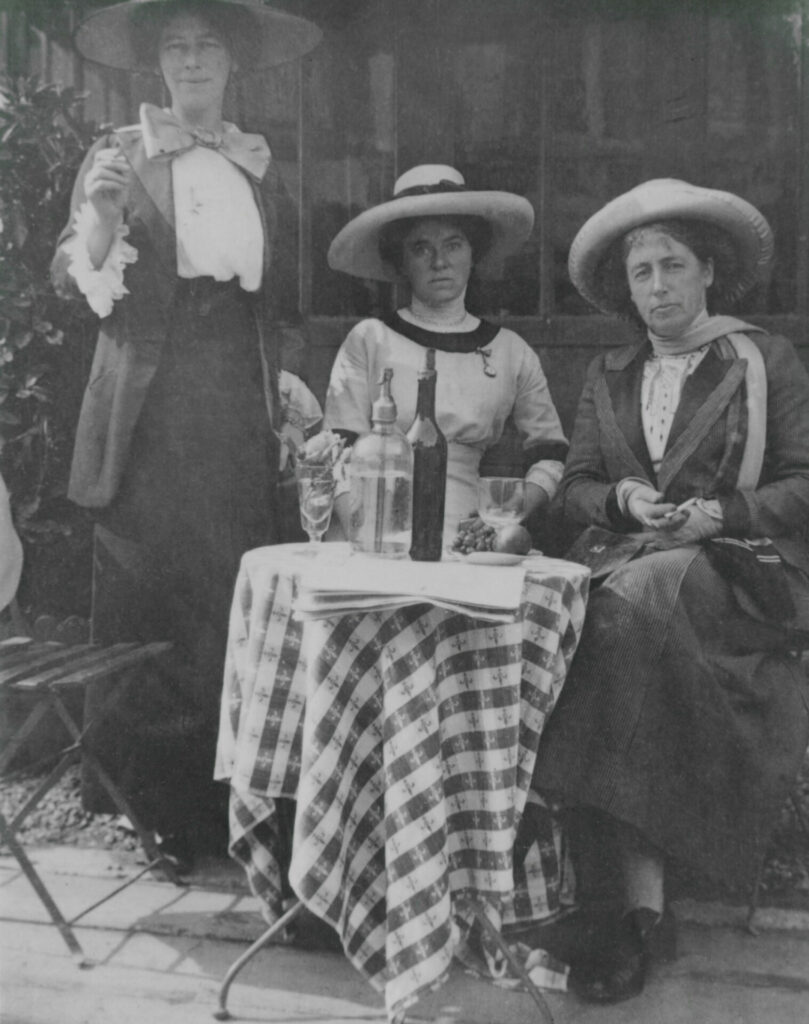
Frances Hodgkins with Two of Her Pupils at St Valery-sur-Somme
E H McCormick Papers, E H McCormick Research Library, Auckland Art Gallery Toi o Tamaki, gift of Linda Gill, 2015
Arthur Lett-Haines (1894-1978)
Jardin d’Artiste 1969
Mixed media on paper, 57 x 35.5 cm Signed Lett & dated June‘69
Provenance
Ixion Society, Benton End, Suffolk
Exhibited
Hintlesham Festival, Suffolk
From Frances Hodgkins to Lucy Wertheim, 8th Aug 1930; Flatford Mill, E. Bergholt, Suffolk.
“So very glad to hear all about your latest news. Lett came during the day & I read most of it to him. He was also very pleased that things are going so well, & about Matthew Smith’s interest. He said he had read & filed your letter wh. I had passed on & approved of what you are doing he thought it was all sound sense & good business. He is quite his old self again & his plumage smoothed down.You two mustn’t ruffle up again! … Lett thinks that if you were to give him a small weekly fee he would write articles & get in all sorts of useful & tactful paragraphs. He has rich friends & is a smart fellow & has a lucky touch and is well liked & thought of. Personally speaking I should say his help would be invaluable & we all agree about it”
SOLD
Arthur Lett-Haines was born in Paddington, London in 1894. Known primarily as a surrealist artist he worked in a range of mediums including painting and sculpture. He dedicated most of his life to promoting the artistic careers of those around him.
Lett-Haines attended St Paul’s School in London and went on to study agriculture at the age of 16. At the outbreak of World War I he enlisted with the British Army and served as an officer in the Royal Field Artillery. During the war years he met and married Gertrude Aimee Lincoln, reputed to be the grand-daughter of President Abraham Lincoln.
After the war Lett-Haines became involved with an artistic group based in Chelsea, London, which included among its members D H Lawrence and the Sitwells. He often threw lavish parties, attracting local artists and writers such as New Zealand writer Katherine Mansfield. In 1918 during one of these parties, he met artist Cedric Morris. Morris quickly moved in with Lett-Haines and his wife in Wilmington, Sussex, resulting in the separation of the couple with Gertrude returning to America the following year. They continued to live together as a couple for some sixty years.
In 1918 Lett-Haines and Morris met artist Frances Hodgkins and a close friendship soon blossomed. Morris and Lett- Haines visited her studio in Kensington where they found the walls full of coloured paintings. In 1919, they moved to Newlyn to attend the Newlyn School. The friendship among the trio is evident in the string of portraits they made of one another. A drawing of Hodgkins by Lett-Haines from 1919 is currently held at the National Portrait Gallery in London and Hodgkins’ 1920 portrait of Lett-Haines (FH0665) is held in the Museum of New Zealand Te Papa Tongarewa. Her portrait of Cedric Morris is held in the Towner Art Gallery, U.K. (bequeathed by Lucy Wertheim). Hodgkins was a great influence on Lett-Haines, encouraging him to paint in oil and experiment in post-impressionism.
In 1920 Lett-Haines and Morris moved to Paris where they became involved with a group of expatriate artists including Juan Gris, Marcel Duchamp and Ernest Hemingway. During this time, Lett-Haines studied sculpture at the Académie Colarossi, Paris. New Zealand artists Sydney Lough Thompson and Helen Stewart were also students at the academy.1
In 1926 Lett-Haines was the only British artist to be shown at the International Exhibition of Modern Art at the Brooklyn Museum, New York. He was described by collector Katherine Dreier as “the only Englishman showing understanding of what the Modernists claim as their point of view.” Following this exhibition, Lett-Haines and Morris moved back to London before settling in Suffolk in 1929.
In 1937 Lett-Haines and Morris founded the East Anglian School of Painting and Drawing in Dedham. The school was short-lived as the building burnt down in 1939. They moved to a temporary location but soon settled in Hadleigh in a house named Benton End. Locals regarded this property as the“Art House”. His time in the garden at Benton End was a great influence on his works and many of his paintings followed a surrealist nature, featuring human bodies.
Lett-Haines died in 1978, forcing the school to close. Morris continued to live in their home until his death in 1982. The couple are buried near each other at Hadleigh Cemetery. A retrospective exhibition was held at Redfern Gallery for both Morris and Lett-Haines titled Teaching Art and Life in 1984. Lett-Haines’ work can be found in the collection of the Tate Gallery, London, Museum of New Zealand Te Papa Tongarewa, Wellington, and private collections throughout Britain, Europe and New Zealand.
– Kaitlin Stewart
Christopher Wood (1901-1930)
The Sloop Inn, St Ives
Pencil on paper laid on card, 20 x 20 cm
Executed in 1926
Provenance
The artist’s family until 1959
Redfern Gallery, London 1959
Dr Leonard D Hamilton, purchased from above 12 June 1959
SOLD
Christopher Wood was born in Knowsley, near Liverpool, on April 7th 1901. He attended the Marlborough College in Wiltshire, and went on to study medicine and architecture at Liverpool University in 1919. While at University, Wood met Welsh painter Augustus John who encouraged him to become an artist.
Upon his decision to pursue an artistic career he met French collector Alphonse Kahn, who invited him to Paris where he enrolled at the Académie Julian in 1921. He became involved with a wealthy Chilean diplomat, Tony Gandarillas. Gandarillas not only supported Wood financially but introduced him to artists Pablo Picasso, Georges Auric and Jean Cocteau who became great influences on Wood. The drug opium was being widely used by artists in Paris at the time, and the hallucinogenic effect had an impact on the surrealist quality of Wood’s work but came at a cost to his mental wellbeing.
Throughout the early 1920s Wood travelled between Europe and North Africa with Gandarillas. In 1926 Wood became a member of The London Group and in 1927 joined the Seven and Five Society. Frances Hodgkins exhibited with The London Group in 1927 and joined the Seven and Five Society in 1929 after being introduced to the group by artist Cedric Morris. Hodgkins exhibited alongside Wood in the 9th Exhibition of the Seven and Five Society in 1929. It was through this gathering of artists that Wood came into contact with Ben and Winifred Nicholson.
Wood painted with the Nicholsons in Cumberland and Cornwall in 1928. The Cornish seaside made a great impact on Wood which led him to the artist and fisherman Alfred Wallis, who is well known for his naïve technique. His works were dominated by a skewed perspective and disproportionate objects. His time in Cornwall produced many notable works featuring seascapes, fishermen and boathouses. Wood created his own style during his stay in Cornwall. The importance of a figure or character was held at the forefront whilst working within Wallis’ naïve approach. He went on to spend a summer in Brittany, settling in Tréboul before returning to England for upcoming exhibitions.
In April 1929 Wood held a solo exhibition at Tooths Gallery, London, where he met Lucy Wertheim, Hodgkins’ gallerist friend and dealer. Wertheim purchased a work and arranged for an exhibition to be held at her gallery in London the following year. This was Wertheim’s first gallery, set to open in 1930. It was through the help of Hodgkins, Wood, (who was often referred to as ‘Kit’) and Cedric Morris that the name of the gallery was established.
In a letter from Frances Hodgkins to Lucy Wertheim on August 4th 1930 she wrote:
“We unanimously agreed to ask you as a great favour to reconsider the name of “Young Masters” & call yr gallery simply The Wertheim Gallery. To begin with yr main planks & supports (say Cedric – Matthew Smith Kit Wood – A Robinson?) … These men do know what they are talking about. It is their world you know.”
In May 1930 Wood exhibited alongside Ben Nicholson at Galerie Bernheim, Paris. This show featured paintings Wood completed during his time in Brittany the previous year. The show was not a great success and this caused his frenzied state as he prepared for the exhibition to open at Wertheim Gallery in October.
In August 1930, Wood met with his mother and sister in Salisbury to show them a selection of paintings for the upcoming exhibition. At this point he was suffering greatly from opium withdrawals which caused him to take his own life. An exhibition following his death was held in Wertheim Gallery in 1931 as well as Lefevre Gallery, London in 1932. In 1938 Wood’s paintings were included in the British pavilion at the Venice Biennale. In the same year a major exhibition was organised by the Redfern Gallery at the New Burlington Galleries, London.
In 1948 Lucy Wertheim gifted an oil painting by Christopher Wood titled The Sloop Inn, St Ives to Auckland Art Gallery Toi o Tamaki. This oil painting was completed in 1926 during his time in Cornwall. The work depicts an everyday scene of locals gathering outside a seaside pub. The present drawing held by Jonathan Grant Gallery is the working sketch for the completed canvas.
– Kaitlin Stewart
Agnes Drey (1890-1957)
Woman With Shopping Basket
Oil on canvas, 75 x 49.5 cm
Signed lower right
Provenance
WH Lane & Co, Penzance, 15 Sep 1988
Purchased by Wilhelmina Barns-Graham from above, 1988
From Frances Hodgkins to Hannah Ritchie, 8th July 1924; Hotel Belle Vue Montreuil s-mer
“Agnes Drey settled down to work, hard at it, putting paint all over her self. She or I, or both, take the 3 terrier dogs out walks in the evening. Yesterday one killed a chicken, only a little one & she had to pay 4 frcs. Such a scene. Somehow I like her much better in France. She seems more natural & in her proper setting. She speaks easily & loves the people – they also like her.“
SOLD
Agnes Drey was born in Charlton, Lancashire in 1890. She was the sister of Oscar Raymond Drey, an art and theatre critic who went on to marry artist Anne Estelle Rice. Anne’s sister, Eleanor Emily Rice became a good friend to Drey. In 1918 Anne Estelle Rice met the New Zealand author Katherine Mansfield in Cornwall and painted her portrait which is now held in the Museum of New Zealand Te Papa Tongarewa collection.
Whilst in France in 1924, Drey joined Frances Hodgkins’ summer sketching classes at Montreuil-sur-Mer. She introduced Hodgkins to her brother Raymond and his wife Anne. Whilst attending an afternoon tea party at the Drey home in Withington, Manchester in 1926 Hodgkins met Lucy Wertheim and this introduction prompted a lifelong friendship. Drey painted a portrait of Hodgkins that was displayed in Auckland Art Gallery Toi o T¯amaki’s exhibition Frances Hodgkins: European Journeys held in 2019. Hodgkins gifted Drey a painting titled St Paul du Var (FH0760, Private Collection) in 1924. Raymond Drey was also a supporter of Frances Hodgkins, purchasing two of her works painted in 1942; Dolaucothy Arms (FH1208) and Welsh Emblem (FH1222, Private Collection).
Drey’s first exhibition was in 1934 at the Back Road West Studios in Cornwall which consisted mostly of still lifes and portraits. She was a founding-member of the Penwith Society which was formed in 1949 and based in St Ives, Cornwall. The group included artists Barbara Hepworth, Peter Lanyon and Ben Nicholson.
Drey worked in Studio 2 at Porthmeor Studios throughout the 1950s. The studio was located next door to Wilhelmina Barns-Graham, a British artist who later purchased the present work Woman with Shopping Basket in 1988. Barns-Graham (1912-2004) was part of the St Ives School of artists of the mid-20th century. Willie, as she was known, built up an astonishing collection of works from friends such as Terry Frost, Barbara Hepworth, Patrick Heron, Roger and Rose Hilton, Bernard and Janet Leach, Denis Mitchell, Ben and Kate Nicholson, Breon O’Casey, Alfred Wallis and Agnes Drey.
Throughout her career Drey exhibited with the Women’s International Art Club, the Newlyn & St Ives Societies, Lanham’s Gallery and Castle Inn in St Ives. Drey lived in Cornwall permanently from the 1930s until her death in 1957. A memorial exhibition was held for her by the Penwith Gallery.
– Kaitlin Stewart
Eve Disher (1894-1991)
Ennui
Gouache on paper, 55 x 38 cm
Signed & dated ‘60
From Frances Hodgkins to Lucy Wertheim, 3rd Jul 1930; The White Horse Hotel, E. Bergholt, Suffolk
“I am glad dear little Eve is so satisfactory. She has rare common sense behind that charm. Trust her. Now for Cedric. Thanks again dear Luce.”
SOLD
Eve Disher was born in London in 1894. She studied at the Hornsey College of Art in Crouch End, London. As the First World War erupted Disher began working for the London Fire Brigade.
In 1918 she ran away from home and married the theatre critic of the Evening Standard, Maurice Wilson Disher. He was connected to the Bloomsbury Group, an association of English writers, philosophers and artists. The couple moved into a house in Gordon Square belonging to the Strachey family. Lytton Strachey was a founding member of the Bloomsbury Group who introduced Disher to the well-known writer Virginia Woolf. The marriage soon ended, forcing Disher to move in with artist Vera Cuningham. Cuningham had a great influence on Disher’s works.
Throughout this time Disher travelled extensively through South Africa and Jamaica and in the late 1920s she became involved with filmmaker Arthur Elton. Through Elton, Disher came into contact with British artists Cedric Morris and Duncan Grant. In a letter from Cedric to Arthur Lett-Haines in 1939, he wrote of Eve Disher, who had been asking him to hold portrait classes in London at Carl Thompsons’ studio.
Disher first came into contact with Frances Hodgkins during the 1920s through her good friends Morris and Lett-Haines. Hodgkins had written to Lucy Wertheim on several occasions about Eve and her work, suggesting that Wertheim should add her to her stable of ‘Young Masters’. She mentioned Disher in a letter to Lucy Wertheim, her gallerist, on July 3rd 1930: “I am glad dear little Eve is so satisfactory. She has rare common sense behind that charm. Trust her.” In 1934 Hodgkins gifted Disher a 1933 watercolour titled Ibiza (FH1287) inscribing it “To Eve from Frances Hodgkins 10.10.34”.
Disher is highly regarded for her portrait works. Her technique of using a dry brush to drag and blot gouache across the canvas became a distinguishing feature in her work. A portrait painted by Disher of J.B.S Haldane in 1936 is held at the National Portrait Gallery in London.
Disher exhibited with the Society of Women Artists, the Women’s International Art Club and the Matthiesen Gallery in London. In 1987 she held a solo exhibition at the Foyles Art Gallery in London.
– Kaitlin Stewart
From Frances Hodgkins to William Hodgkins, 12th November 1931, 6 Fitzroy St, London WC2
“When did I last write? April? An awful long time ago – I was in France. I stayed there till mid August, more or less in company with Maud & George Burge, who were, owing to bad times, economising (if it was not really so serious some of the richer of one’s friends’ economies would make one laugh) in one of the less fashionable of the Riviera resorts – St Tropez. A famous artists place but now grown pretentious & expensive, tho’ still very lovely.”
SOLD
Maud Burge (née Williams) was a New Zealand artist who painted primarily in oils and watercolours. Her work was heavily influenced by her studies and travels throughout Europe.
Burge was born in Wellington, the third of thirteen children. Her grandfather, Henry Williams, translated the Treaty of Waitangi from English to Te Reo, and his wife Marianne Williams was a pioneering educator within New Zealand. Her other grandfather, William Beetham, painted portraits.
Burge was heavily influenced by the work of New Zealand artist James Nairn, who was renowned for portraits and landscapes painted using the en plein air approach. Around the turn of the century she painted portraits at Charles Frederick Goldie’s studio in Auckland. Under his tutelage Burge painted Ina Te Papatahi of the Ng¯apuhi iwi, who was one of Goldie’s earliest models.
In 1909 she married George Aylesford Burge and the couple left New Zealand for Europe soon after. Burge studied in France and was a pupil of English watercolourist Fred Mayer. She spent time painting in locations such as Concarneau, Saint-Tropez, Morocco and Dalmatia depicting beach and market scenes. Burge exhibited with the New Zealand Academy of Fine Arts under her maiden name, Williams, from 1883–1906; and then from 1926, under her married name.
Frances Hodgkins most likely met Maud through her sister, Isabel Field, in Wellington. In 1924, Hodgkins described Maud, then living in Montreuil, “as a charming but changeable woman”. Hodgkins painted in the Burges’ garden in Saint-Tropez in 1931 and joined them the following year in Mallorca and Ibiza. Maud accompanied Hodgkins on several painting expeditions in Ibiza along with fellow artists Gwen Knight and May Smith.
In 1937 the Burges returned to New Zealand, settling in Taupo and then later at Cole Street in Masterton. Maud Burge died in 1957 at the age of ninety-two and is buried in Masterton Cemetery.
In 1988 an exhibition titled Frances Hodgkins – Maud Burge: Two Expatriates: an Exhibition of Paintings & Drawings was held at the Hawkes Bay Art Gallery.
– Kaitlin Stewart
Norman Garstin (1847 – 1926)
Ludlow 1919
Watercolour, 24 x 20 cm
Signed
From Frances Hodgkins to Rachel Hodgkins, 4 July 1901 Hotel de France, Caudebec en Caux
SOLD
Norman Garstin was born on the 28th of August 1847 in Caherconlish, Ireland. His paintings are associated with the en plein-air technique, with heavy influence from French impressionists such as Édouard Manet. Garstin’s inspiration also hails from Japanese prints and American painters such as James McNeil Whistler. Norman Garstin became a cornerstone in Cornwall’s Newlyn School.
Garstin attended Victoria College on the island of Jersey, following a passion for architecture and engineering. He ventured abroad and travelled to Cape Town, South Africa where he met Cecil Rhodes and began a career in journalism. Discontent and struck with a desire to pursue a career in art, in 1880 he attended the Royal Academy in Antwerp, Belgium. This compelled a move to Paris where he further studied from 1882 to 1884 in the studio of artist Carolus Duran. During his time in Paris he met Edgar Degas and became keenly interested in French Impressionism. Following his studies, he travelled throughout Europe visiting Spain, Morocco, Venice and Italy, embarking on the completion of his first professional paintings. Garstin first exhibited in 1883 at the Royal Hibernian Academy, Dublin, with the painting ‘Bird’s Nesting’ which had been sent from Paris. He regularly exhibited at the RHA in the following years.
In 1888, he met Louisa Jones whom he married and had three children, all of which pursued a career in the fields of journalism and art. They moved to Vernon, Newlyn where Garstin set his roots in the artistic community. He became a member of the New English Art Club (NEAC) and the Newlyn Society of Artists (NSA). In 1895, he became a founding member of the Newlyn Art Gallery which became an exhibition space for the students at Newlyn School of Arts where he taught. This gallery stands today as a prominent feature in the community of Newlyn.
As an avid traveller he took his students to places in Europe where he found great inspiration earlier in his career. In 1901 and 1902, New Zealand artist Frances Hodgkins joined his Summer sketching classes in France where they formed a great friendship. They worked together in Normandy, Brittany, Belgium and Holland. Hodgkins proceeded to write of him and his wife in glowing terms from 1901 to 1914 to her mother Rachel Hodgkins. In 1902 she wrote “they are such dear delightful people but I do wish they had a little more of the world’s goods – living on pictures is a dog’s life”. By 1909 Hodgkins was holding her own classes in Paris and Montreuil-sur-Mer. Despite originally working with Garstin as his pupil he acknowledged her solely as a fellow artist.
4 July 1901 Hotel de France, Caudebec rn Caux to Rachel Hodgkins
“Mr Garstin refuses to accept me as a pupil & will not let me pay a penny he seems to think I have nothing to learn which is absurd and any help he gives me he says is merely from one brother artist to another. He wants me to work here for a while then go down to Spain for the winter, get plenty of material there then go back to Penzance & take a studio there for a while & get all my sketches in order & then have a show in London in the Spring. He has promised to write me up in the “Studio”, he writes a lot for that paper & has influence. It is a very attractive programme and the most delightful part of it is that Miss Richmond is coming with me. We are at present studying Spanish guide books and making plans.”
In 1919 Hodgkins and Garstin were both holding painting classes in Ludlow. As seen in the painting above, Garstin’s view looks down from Ludlow castle over the bridge to the river below. The same year, Hodgkins painted the watercolour Ludlow Castle (FH0633) which shows the reverse view of the very same scene. Hodgkins perspective shows the river bank looking across the bridge up the castle. This work was exhibited in the exhibition Frances Hodgkins and Her Circle in Jonathan Grant Gallery in 2020.
Garstin died on the 22nd of June 1926 in Penzance, Cornwall. An exhibition of his and his daughter Alethea’s work was sponsored by the Penwith Society of Arts and was featured at the National Gallery of Ireland in 1978. His work can be found at the Tate Gallery and the Victoria and Albert Museum.

